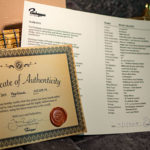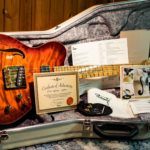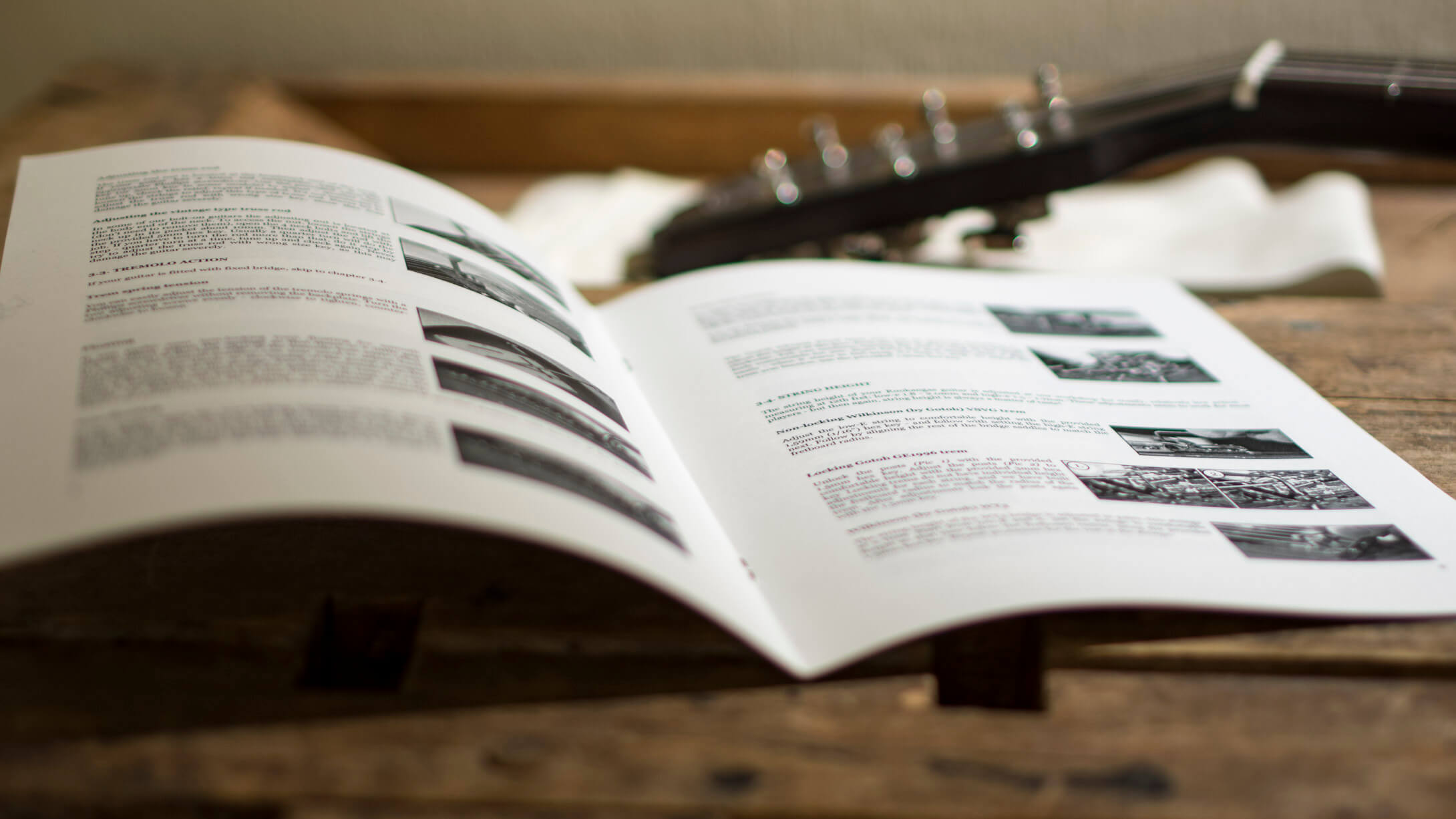
This maintenance guide includes useful information for keeping your Ruokangas guitar well adjusted and clean. We have included instructions for the most common adjustments, but left out repairs – fret dressing, nut filing, refretting etc – that require special tools and skills. We advice you to leave such work for a professional repairshop to do.
Notice that this manual includes info of our most common guitar models. Whenever you notice optional procedures (for example stringing up – various types of tuners), see the warranty card specs sheet for detailed info of your guitar, in case you’re uncertain which instructions to follow.
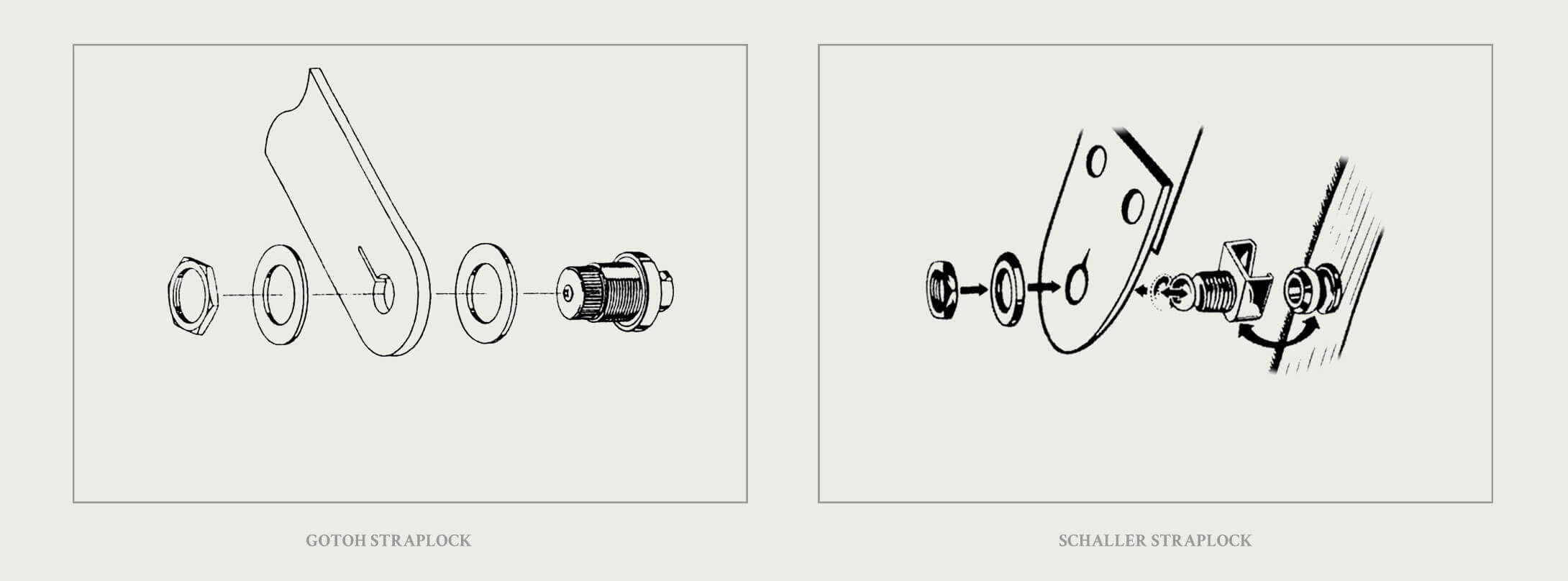
GETTING STARTED – your Ruokangas guitar has been fully adjusted at our workshop in Finland prior shipping to our dealer or directly to you, so usually all you need to do to get started, is to pick up the guitar and play! However, our guitars are made of wood, a living material that may react to changes in humidity and temperature of your environment. In case your guitar needs adjusting, scroll down to see the ‘set-up guide’ section of this manual.
Gotoh Straplocks are a standard feature in all Ruokangas guitars. See the drawing – as installing the lock unit to your strap, remember to tighten the nut well. Adding a drop of threadlocker to the nut is not a bad idea, preventing it opening accidentally. When attaching the strap to the guitar, simply turn the thumbscrew of the lock unit clockwise, slip the lock in and release the thumbscrew. Repeat the procedure to unlock the strap.
Schaller Straplocks – we used to install these to our guitars earlier on. The locking part should be aligned so, that the guitar rests in the “cup” as strapped on. Remember to tighten the nut of the lock unit well. Again, threadlocker to secure the nut would be a good idea. When attaching the strap to the guitar, simply slip the cup to the strap button. To unlock, pull the knob of the lock unit and slip off the cup from the strap button.
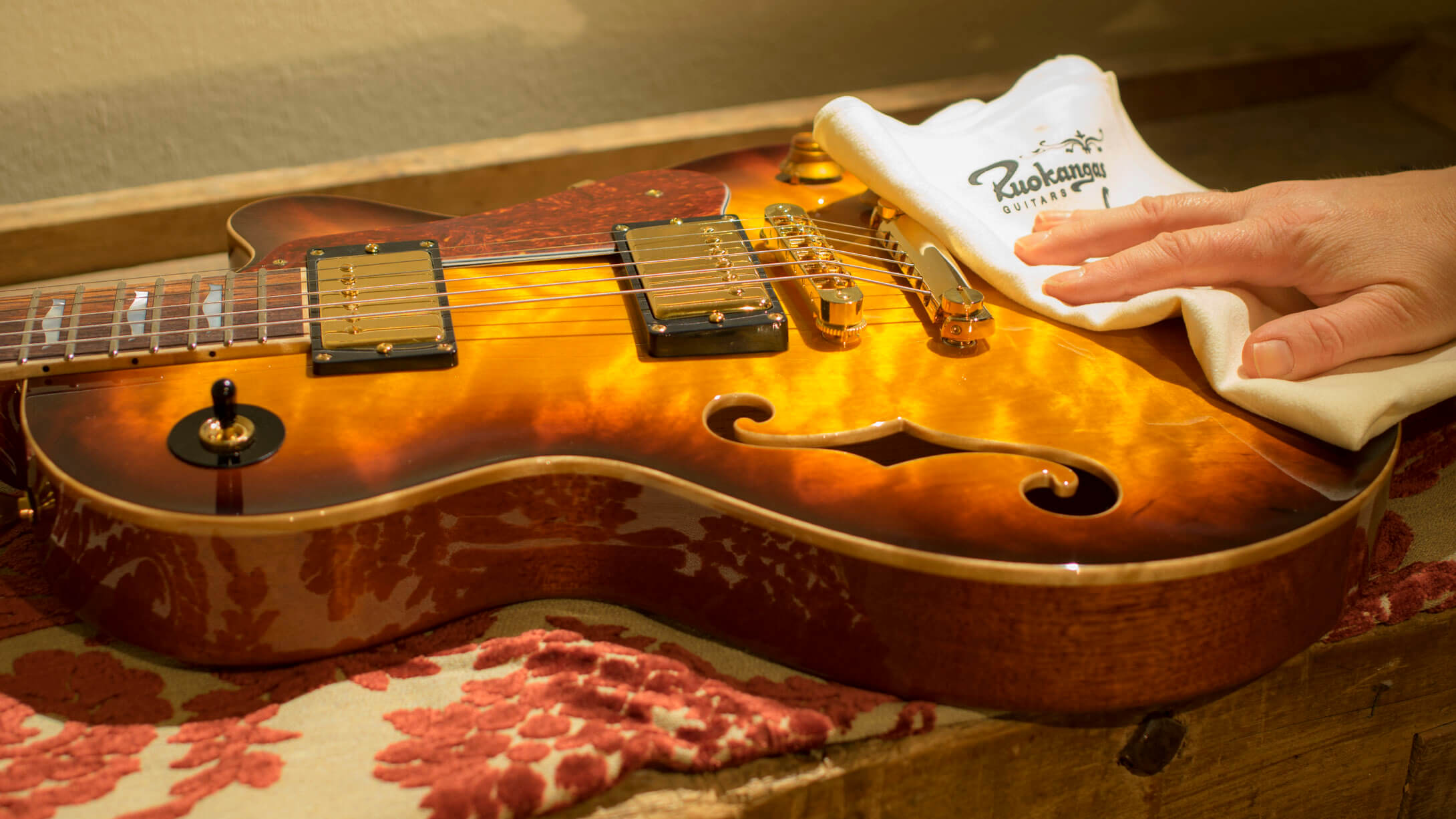
Cleaning the finish – for light cleaning you can simply wipe the guitar with your Ruokangas microcloth provided with the guitar – or you can use any soft cotton cloth, such as an old t-shirt or such. If the guitar needs more thorough cleaning, the finish can be safely cleaned with commercially available guitar polishes available from guitar shops. Look for polish that does not include silicone, abrasives or wax. Our shop favourite is MusicNomad’s product ‘Guitar Detailer’. Great stuff! Spray the polish to the microcloth, wipe on the surface with circular moves and buff to a luster with dry part of the cloth. Guitar polish can be used to clean the pickguard, lacquered maple or birch fretboard and metal parts of your guitar as well. You can use the Guitar Detailer (or a similar guitar cleaning product that does not include abrasives) for your Ruokangas guitar paperthin (with open pores) satin finish as well. Do not use any kind of buffing compound that include abrasives or wax that might build up to the pores of the satin finish, or smudge other sensitive / porous surfaces of the instrument. Notice that guitar polish is meant for cleaning the guitar – it does not remove scratches from the finish. Do not use guitar polish for ebony or rosewood fretboard!
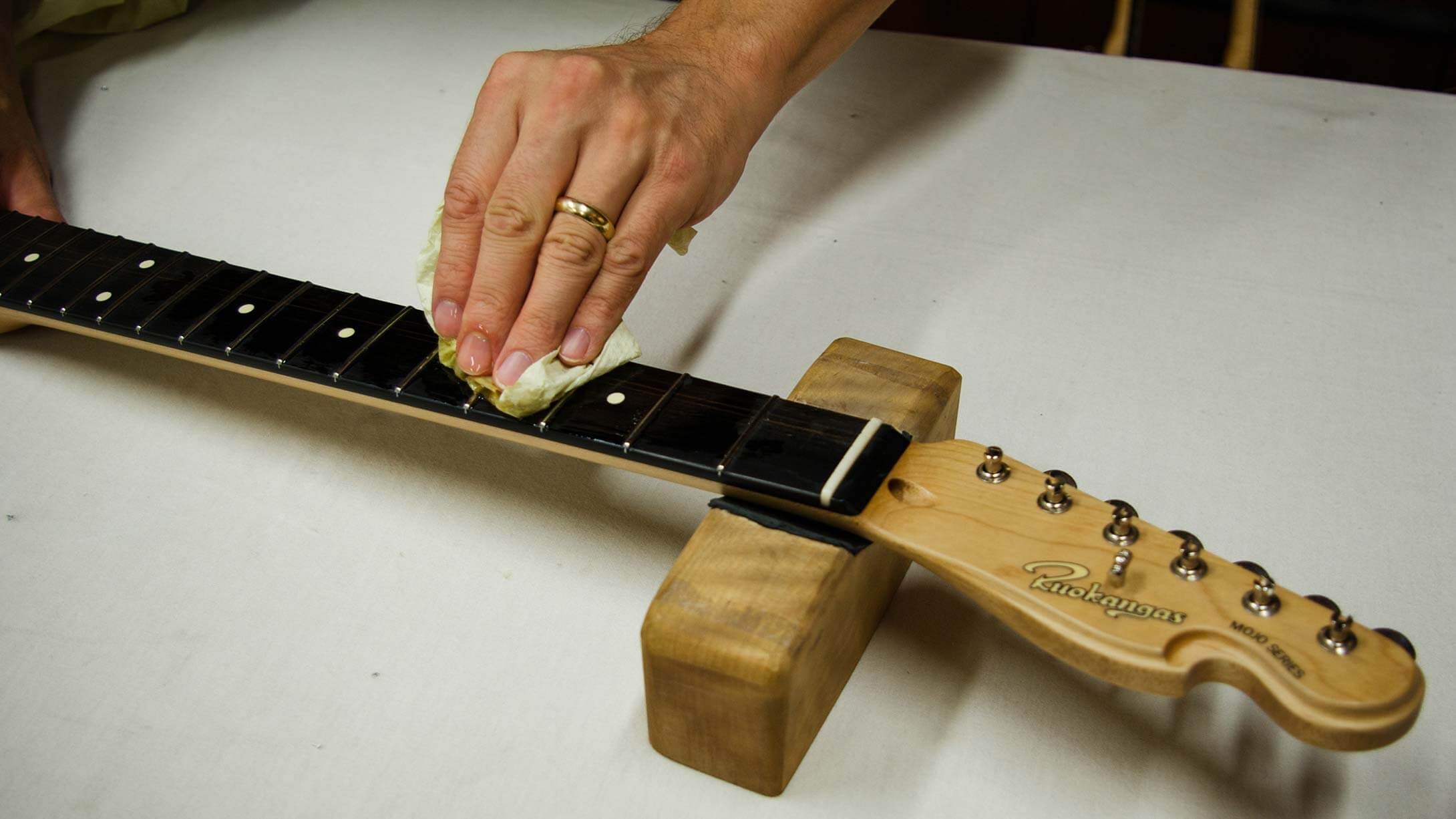
Cleaning the fretboard – rosewood and ebony need to be oiled Occasionally. Once a year or even once in two years is enough. There are a lot of commercially available fretboard oils around. Look for an oil that does not include silicone. Our shop favourite is MusicNomad’s F-One Oil. Works beautifully. So, let’s do it! Remove the strings. Apply oil to a soft paper or piece of cotton cloth and wipe on a generous amount. Wait for awhile (about 1 minute is enough) and wipe off the excess oil with a clean, soft paper or cloth. If your fretboard is very dirty, for example ‘Dunlop Fingerboard Cleaner and Prep No. 01’ works great for melting the dirt off the wood before oiling it.
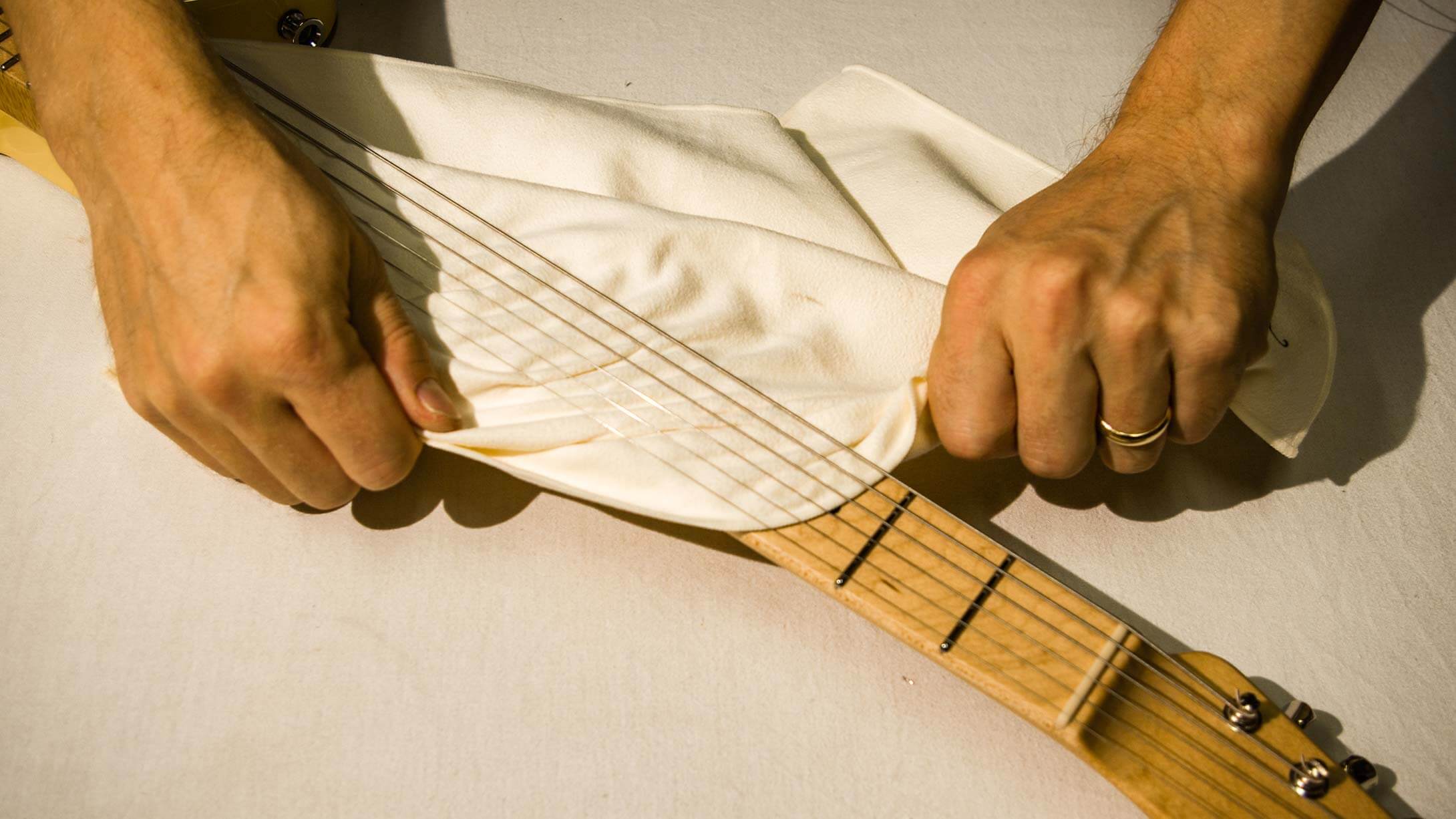
Cleaning the strings – to prolong the life of your guitar strings, there are a couple of useful things to learn and get used to. Wash your hands before playing and wipe the strings clean after playing – a clean cotton cloth will do in most cases, especially with Elixir strings. Don’t forget to clean from under the strings also by slipping the cloth between strings and fretboard. Many players prefer to use commercially available string cleaner compounds as well, such as ‘GHS Fast Fret’ or ‘Dunlop Ultraglide String Conditioner’.

Cleaning the electronics – we use high quality pots and switches, but they will get dirty and wear down eventually. If there are crackling noises as turning the pot or switch, you can clean the part from inside the control cavity with appropriate contact spray available from electronics stores. Look for spray that is specifically made for cleaning and lubricating pots. Our shop favourite is the Deoxit D5. Notice that using the wrong type of chemical (like dry electronics spray) will damage the pots! Apply the chemical slightly, then turn the pot back and forth for a few times. If cleaning doesn’t fix the problem, take the guitar to your local pro repair shop.
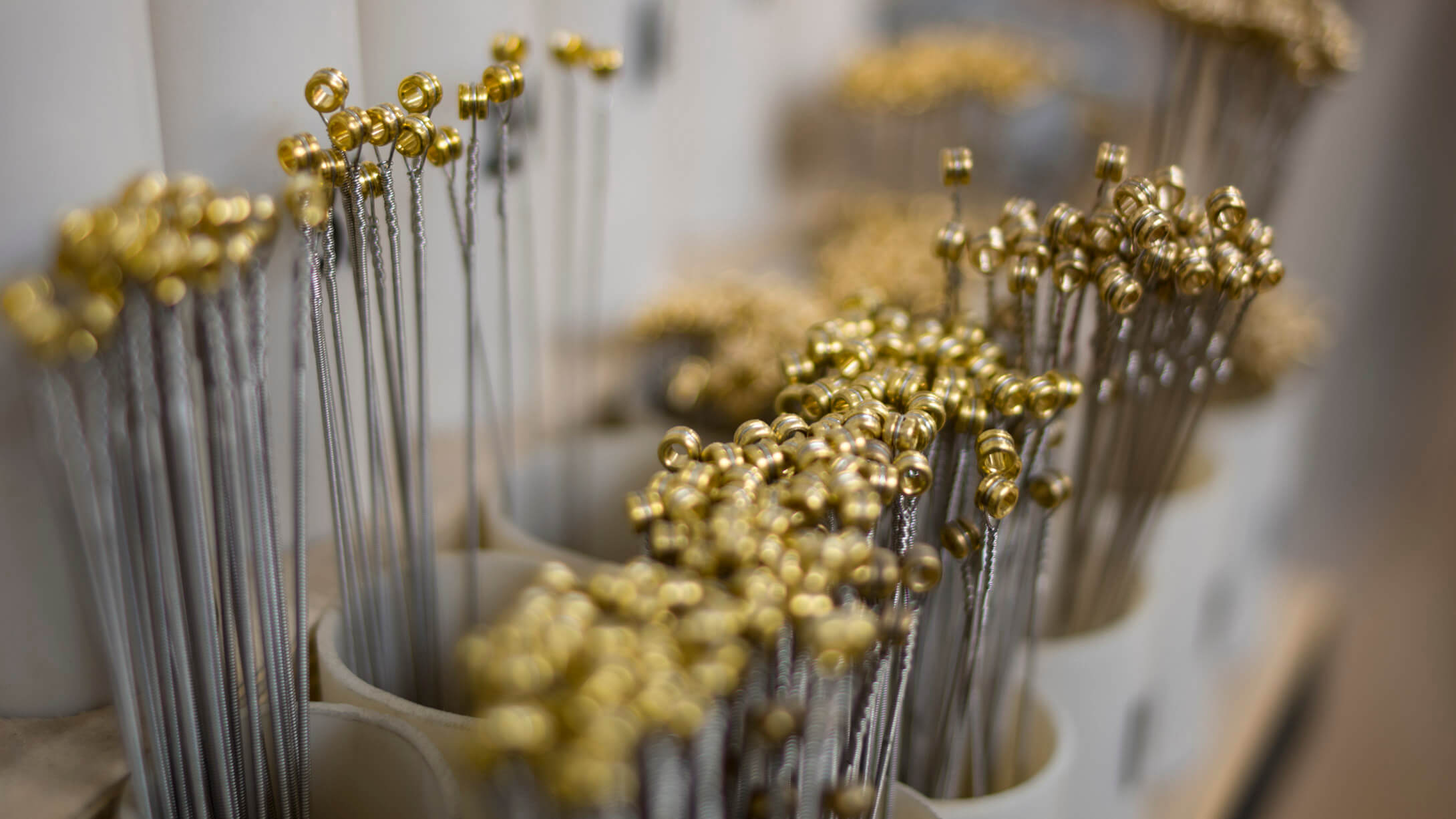
SET-UP GUIDE – first of all, I recommend you to change strings to your Ruokangas guitar regularly to maintain the tone, tuning and playability. It’s also natural that your guitar needs to be adjusted from time to time. When you do a full set-up, follow the precise order described here to achieve the desired result.
Changing strings – if there’s no need to clean or oil the fretboard, you can change the strings one by one. This is especially recommended for guitars equipped with trem to make the tuning up easier. In case you will clean/oil the fretboard, take off all the old strings. If your guitar has a trem, use a piece of folded cardboard to protect the finish behind the bridge before loosening the strings. If your guitar has a locking trem, you need the 3mm hex key provided with the guitar to unlock the nut and to remove the strings from bridge. Loosen the strings from tuners, clip the old strings in half and remove from tuners and bridge.
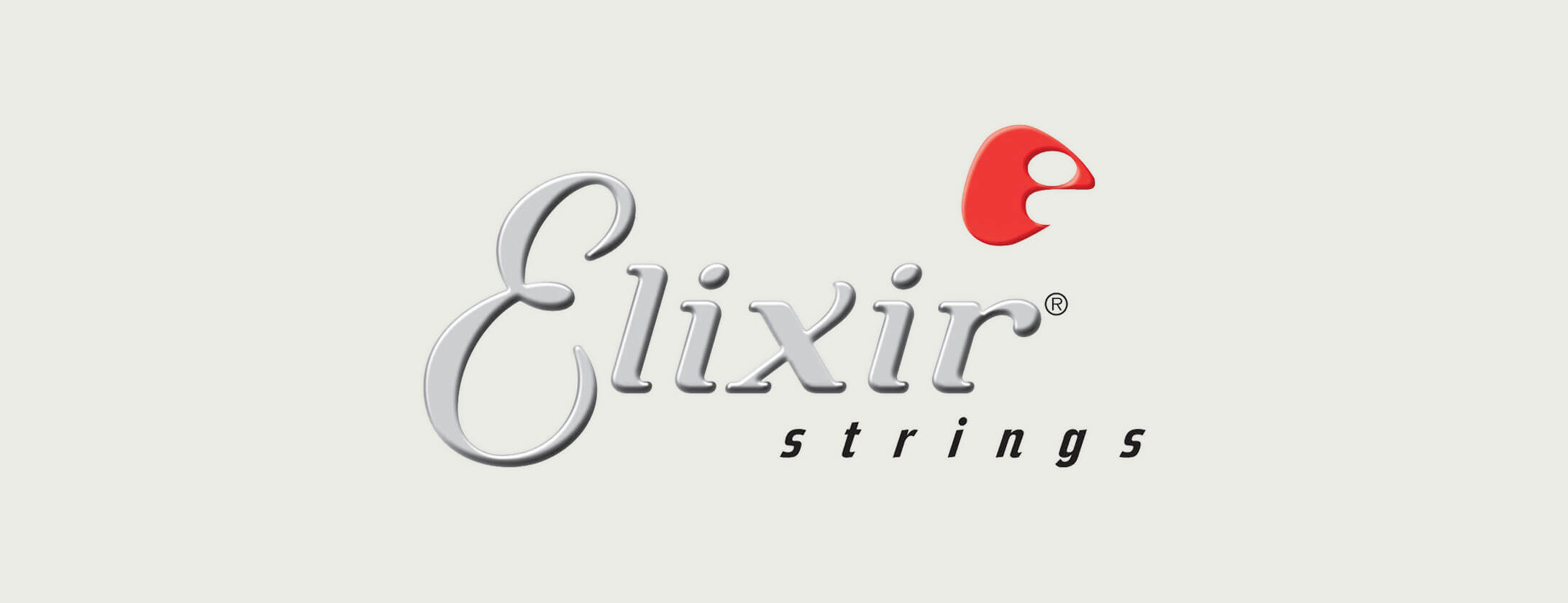
String brands – Ruokangas guitars are stock fitted with Elixir Nanoweb strings that maintain their tone way longer than regular strings. Elixirs have a special coating on wound strings, that prevents dirt and sweat to penetrate to the string. The plain strings have an anti-rust coating as well. If you decide, however, to change string brand, any good quality strings should work fine in your Ruokangas guitar.
String gauges – Ruokangas guitars are typically fitted with 010-046 gauge strings, unless you ordered your guitar with a specified set. If you change to heavier gauge, the truss rod may need tightening – and the nut will most likely have to be modified so the strings slide in the slots smoothly. If you change to lighter gauge, the truss rod may need loosening – and if buzzing noise occurs with open strings, the nut may have to be modified or replaced by a pro repair shop.
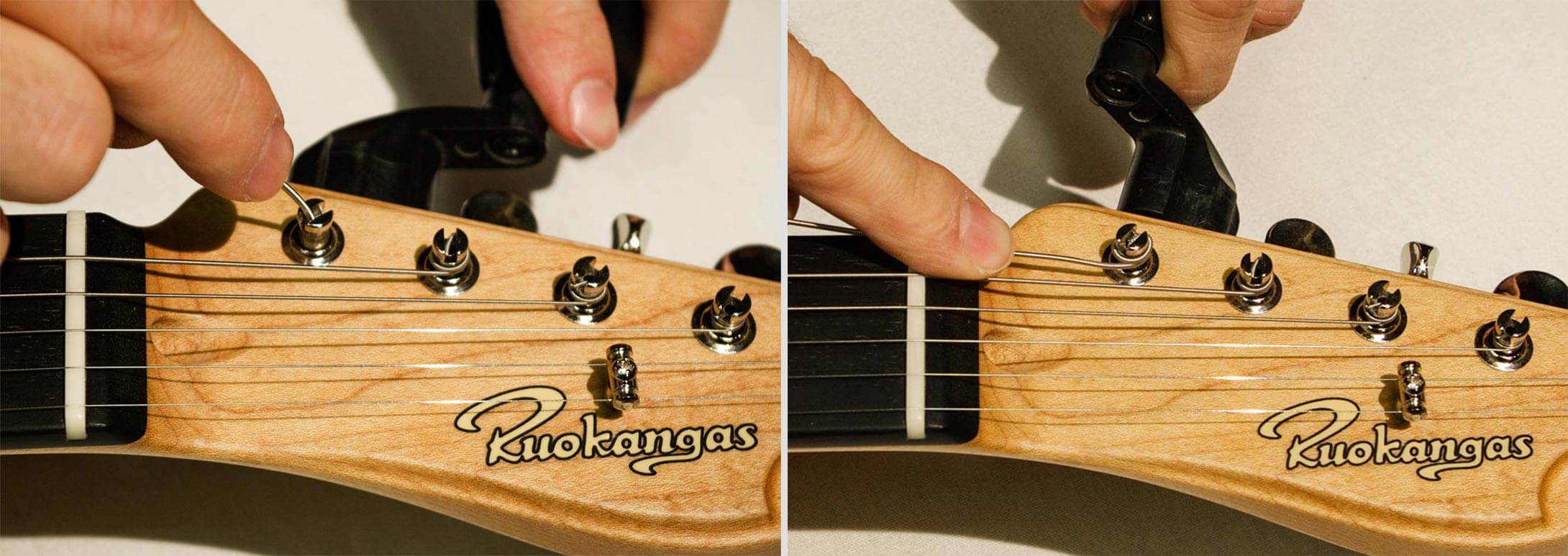
Non-locking Gotoh SD91 Kluson style tuners – these are the Gotoh ”vintage” style 6-in-line tuners with split string posts. This type of tuner is easy to restring, when you remember a couple of things. Cut the new string to appropriate length to avoid overwinding – but don’t cut it too short – a good rule is, that you measure about 2 times the distance from tuner to another and cut from there. Push the new string to the hole on top of the post and start winding. You’ve done a good job, as the string rolls nicely around the tuner post 2-3 times. Tune up to pitch. Hold the string down at first fret and stretch with the other hand. Tune up again.
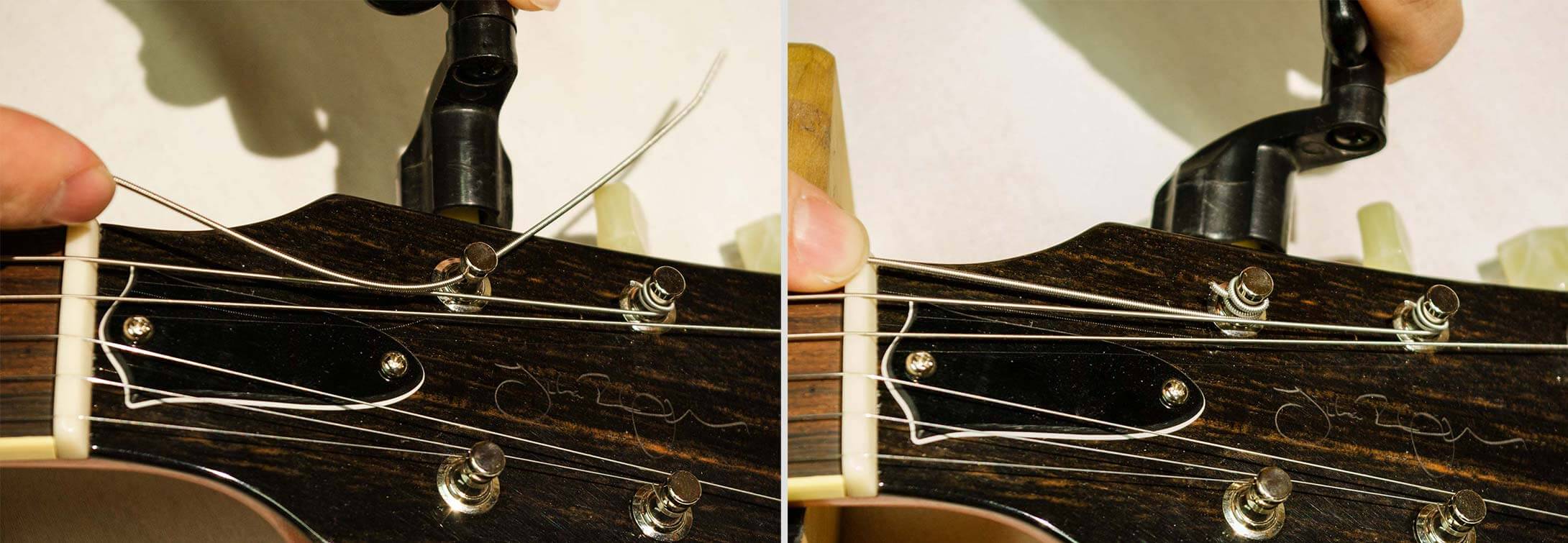
Non-locking Gotoh SD90/SD510/SE700/SG381 tuners – these instructions work for all non-locking Gotoh tuners with hole in the posts. Insert the string into the tuner post hole. Leave enough slack to wind a few turns of string around the posts. Start winding the tuner counter-clockwise. Tune up the string and cut off the excess length. Hold the string down at first fret and stretch with the other hand. Tune up again.
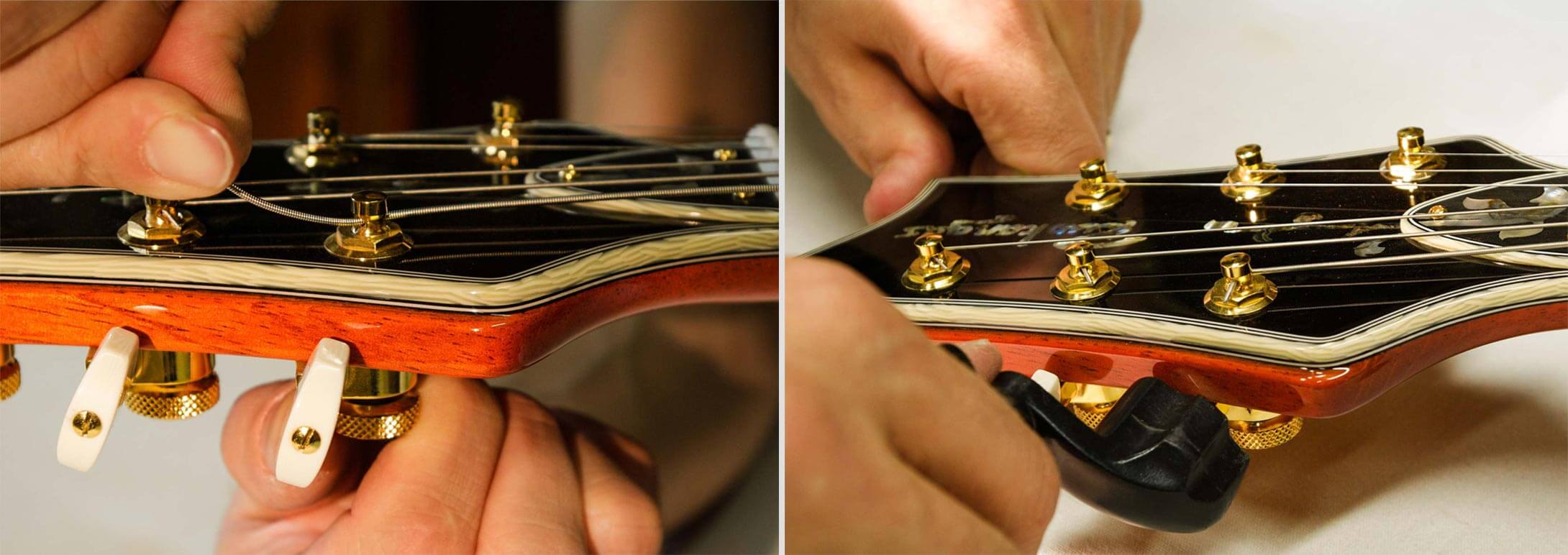
Locking Gotoh MG-T or Schaller M6 – to remove the old string, turn the thumbscrew on the back of the tuner counter-clockwise to unlock the string. Aim a new string through the hole in the tuner post – don’t leave any slack, just pull it straight – and lock the thumbscrew tightly by turning it clockwise. Tune up the string, cut the excess length off. Hold the string down at first fret and stretch with the other hand. Tune up again.
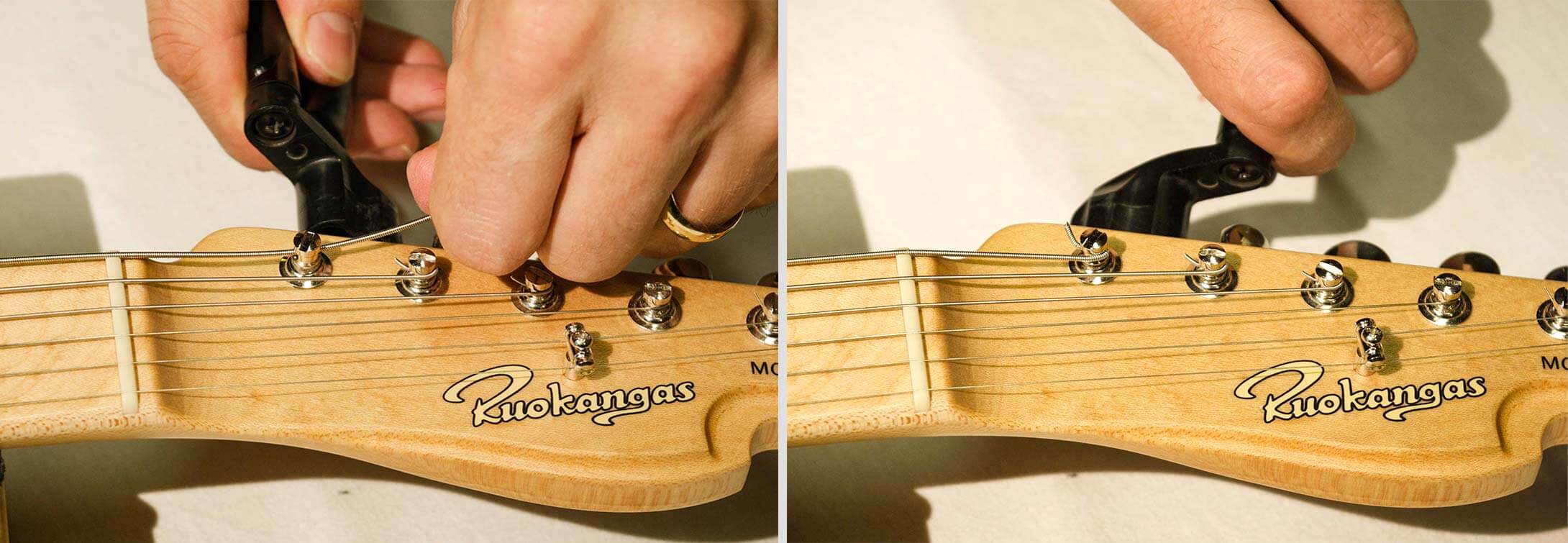
Locking Gotoh SD91/SD510/SGS510/SGL510 tuners – to remove the old strings – pull string back from tuning gear and wind tuner clockwise until string automatically releases. If the string breaks, use a small screwdriver or coin to unlock. Pull the new string tight through tuner hole, leave no slack. Start winding the tuner counter-clockwise and the tuner will automatically pinch and tighten the string. Tune up, cut the excess length off. Hold the string down at first fret and stretch with the other hand. Tune up again.
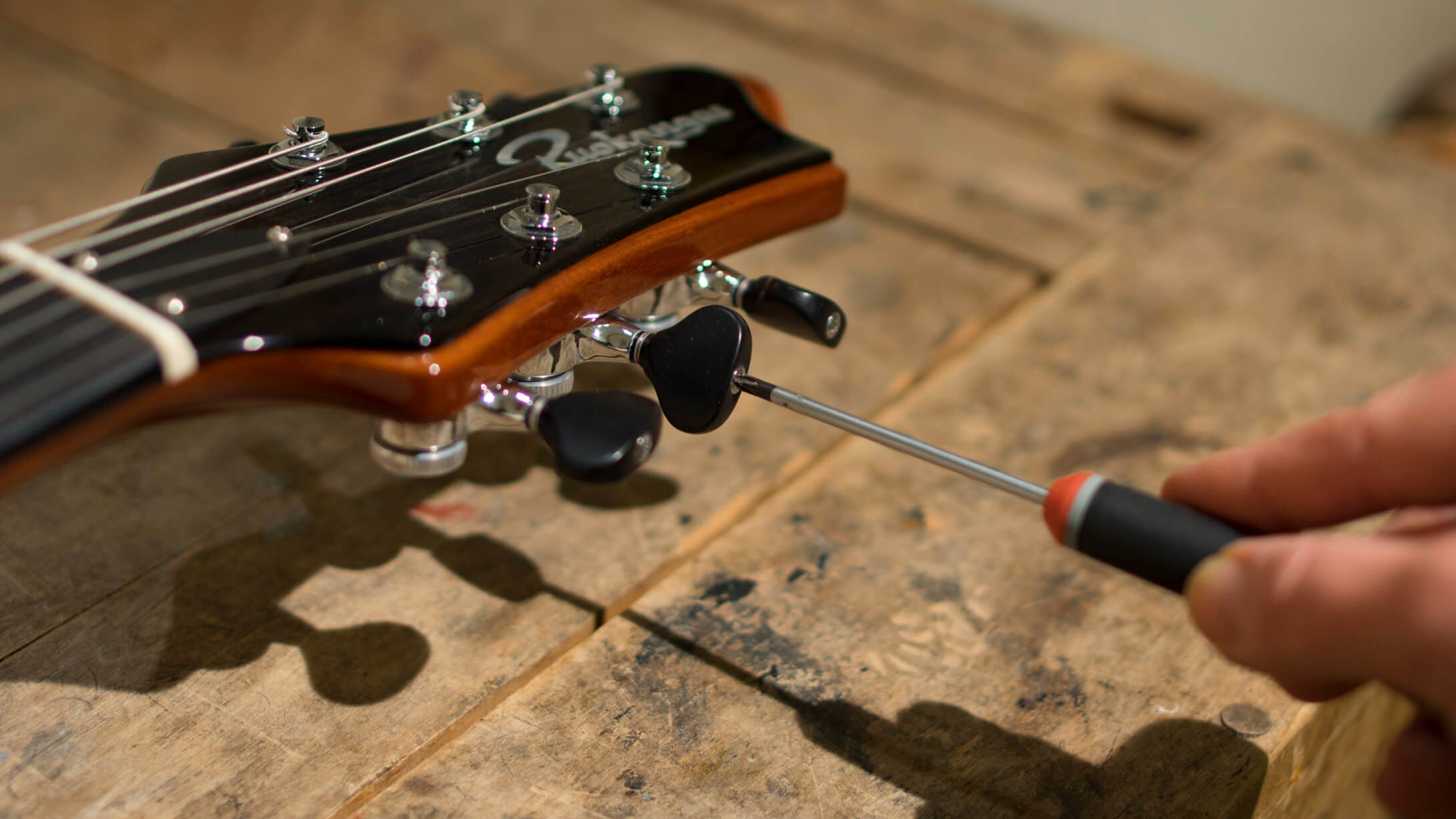
Tuner tension – some of the tuning gears we use have adjustable tension. To tighten the tension, turn the adjustment screw clockwise. Too loose tension may cause the strings to slip out of tune. Set the tension firm. Be careful though – too much tension may cause the tuning gear jam or the tuning knob to break.

Truss rod – ok, now you have new strings fitted in and tuned up. Next, let’s check the neck relief. Hold the guitar in playing position. Simultaneously fret the low-E string on the 1st and last fret (right hand little finger). Check the clearance between the bottom of the string and the top of the 9th fret. While still using the right hand little finger to hold the string at the last fret, you can use the thumb to lightly tap at the 9th fret to more clearly see the gap – which should measure around 0.1 – 0.15mm. If the gap is bigger than that, the truss rod needs to be tightened (clockwise). If there is no gap at all, the truss rod needs to be loosened (counter-clockwise). This gap is called ‘relief’. It’s necessary that the neck has slight relief to allow low action without fret buzz. Adjust the truss rod accordingly with the key provided with your guitar.
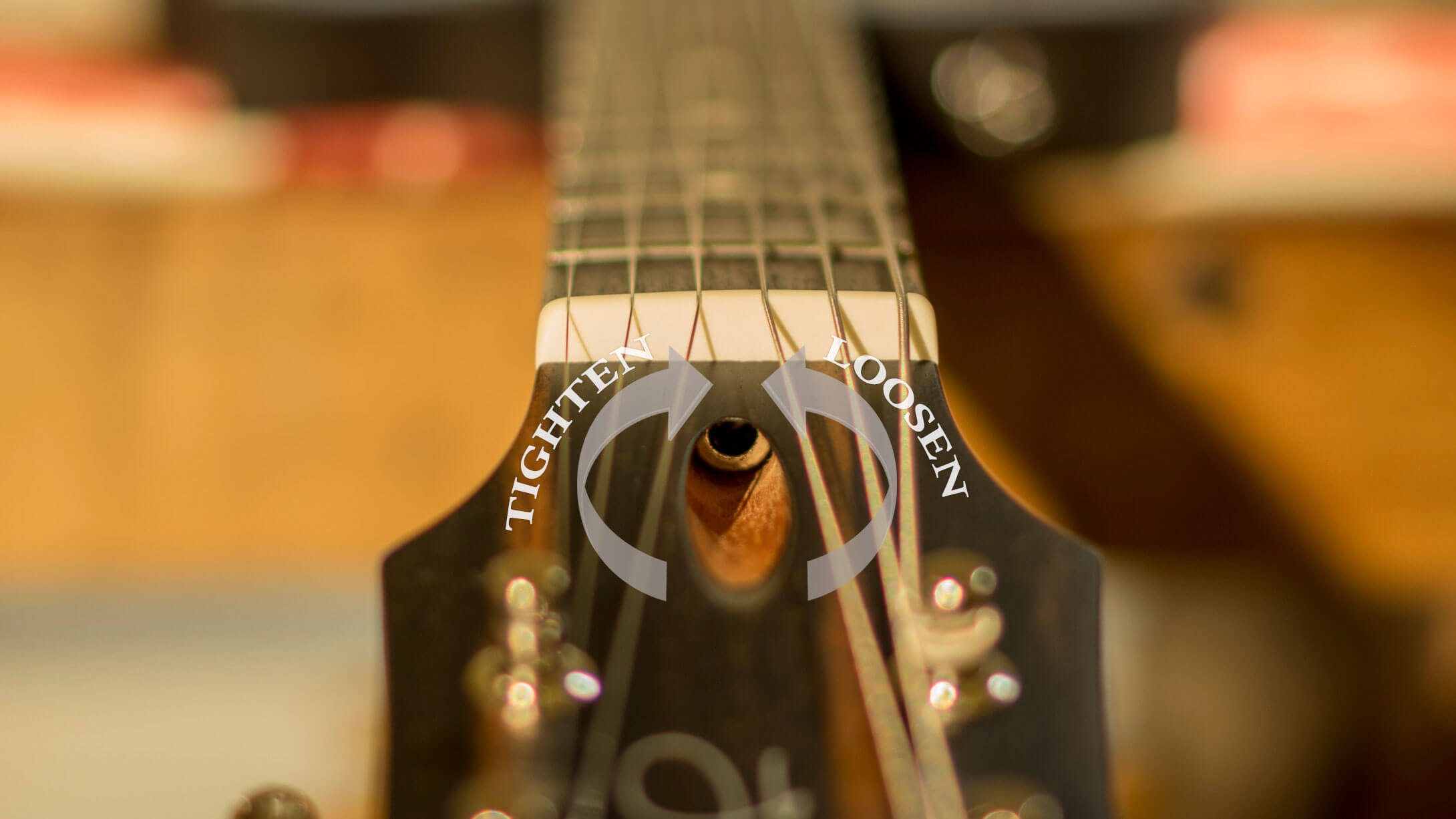
Ruokangas double-way truss rod – every Ruokangas guitar is fitted with a double-way truss rod, which corrects both up- and backbowed necks. The 2-way function ensures, that the neck remains fully adjustable, no matter what kind of climate the guitar is taken to. The truss rod has a zero point, in which the adjusting nut feels loose. Turning the nut clockwise from zero point will tighten the rod – bowing the neck back. Turning the nut counter-clockwise from zero point will loosen the rod more – bowing the neck up.
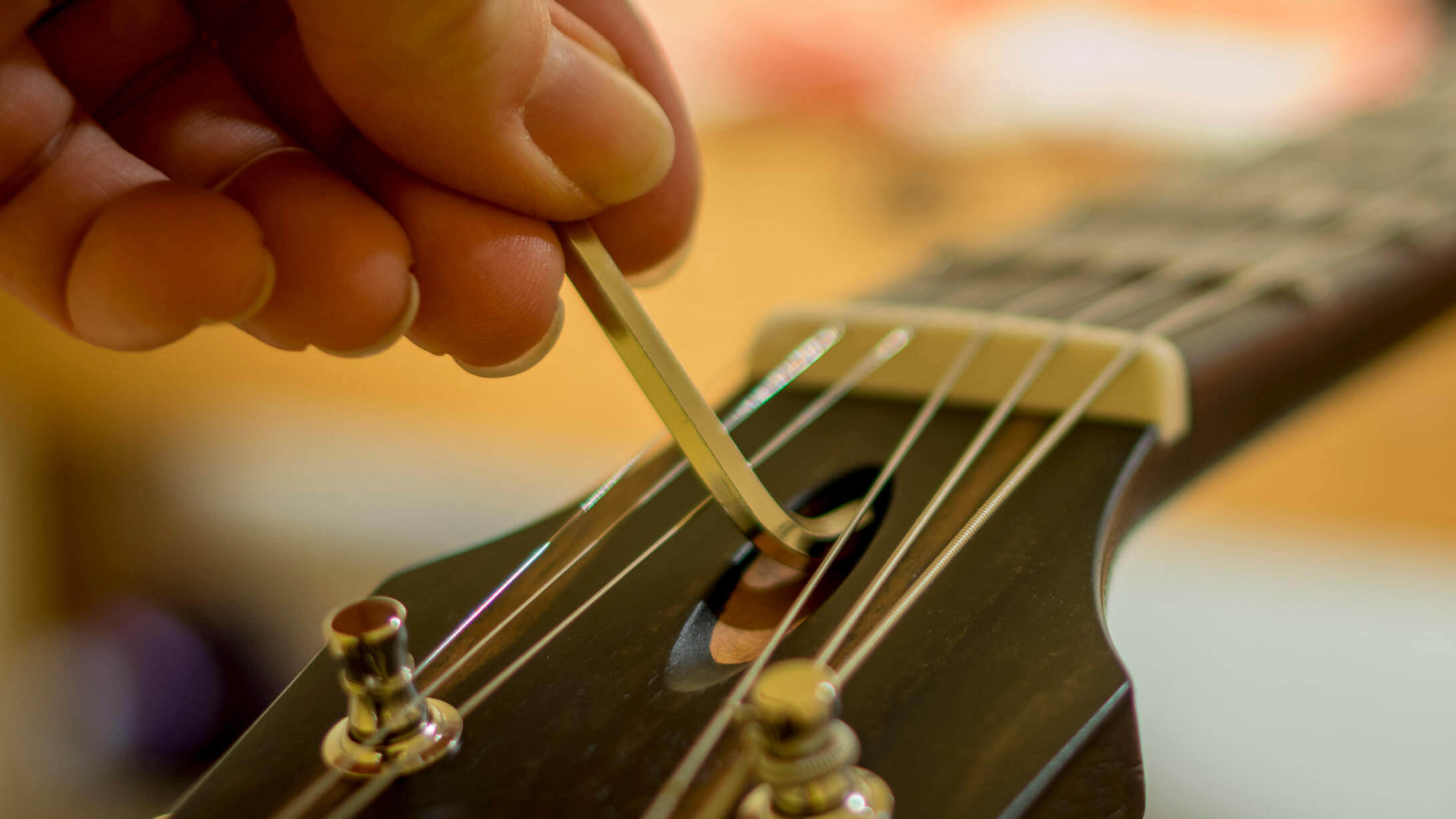
Adjusting the truss rod is easy when the truss rod nut is located at the headstock end of the neck. If your guitar has a truss rod coverplate, open it with appropriate Phillips screwdriver. Use the provided 4mm hex key (or 5mm key in some models) to adjust – quarter turn, tune up, check the relief, repeat if needed. It’s not necessary to loosen the strings to adjust this type of truss rod. Never try to adjust the truss rod with wrong size key, since this may damage the guitar severely.
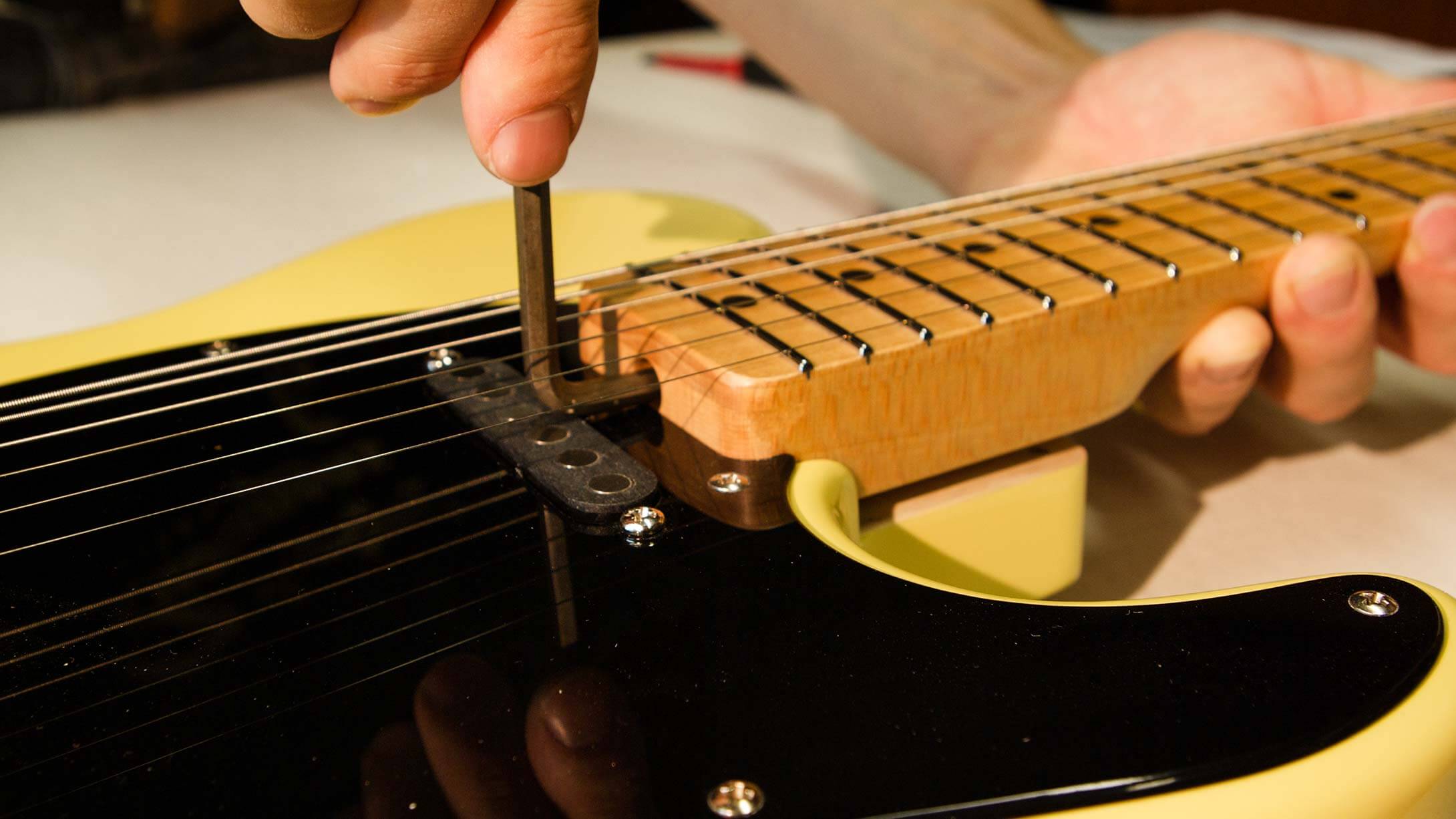
Adjusting the vintage type truss rod – in some of our bolt-on guitars the adjusting nut is located at the body end of the neck. To access the nut, loosen the strings (don’t need to remove them), open the 4 neck bolts and lift the neck up in its pocket about 10mm. Then adjust the rod with the provided 5mm hex key. Usually a quarter turn will do the job. If you have to turn the rod more than that, do it step by step – quarter turn at a time, tune up and check again. Never try to adjust the truss rod with wrong size key, as this may damage the guitar severely.
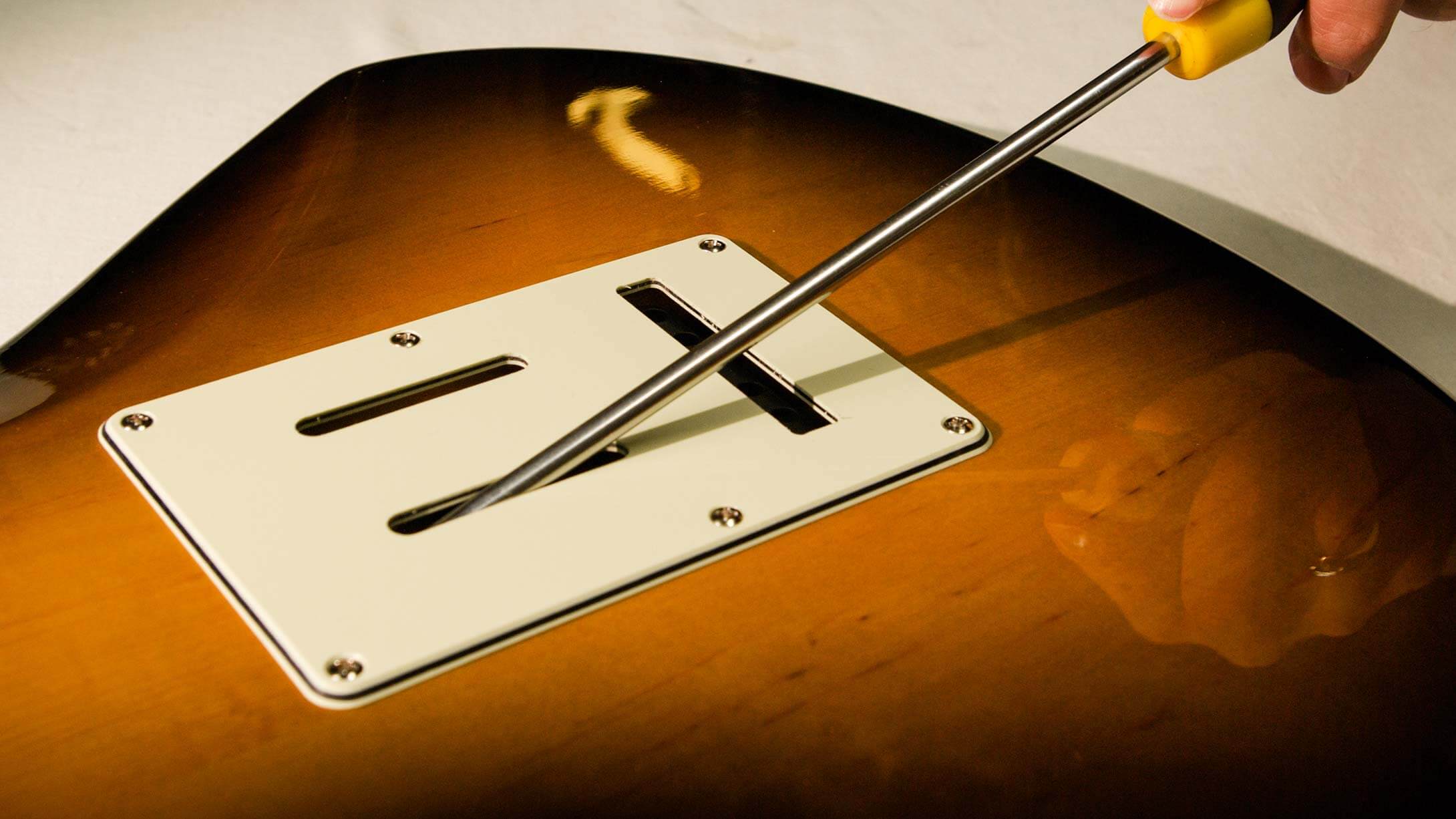
Tremolo action – if your guitar is fitted with fixed bridge, skip this chapter.
Trem spring tension – you can easily adjust the tension of the tremolo springs with a Phillips screwdriver without removing the backplate. Turn the two adjusting screws evenly – clockwise to tighten, counter-clockwise to loosen.
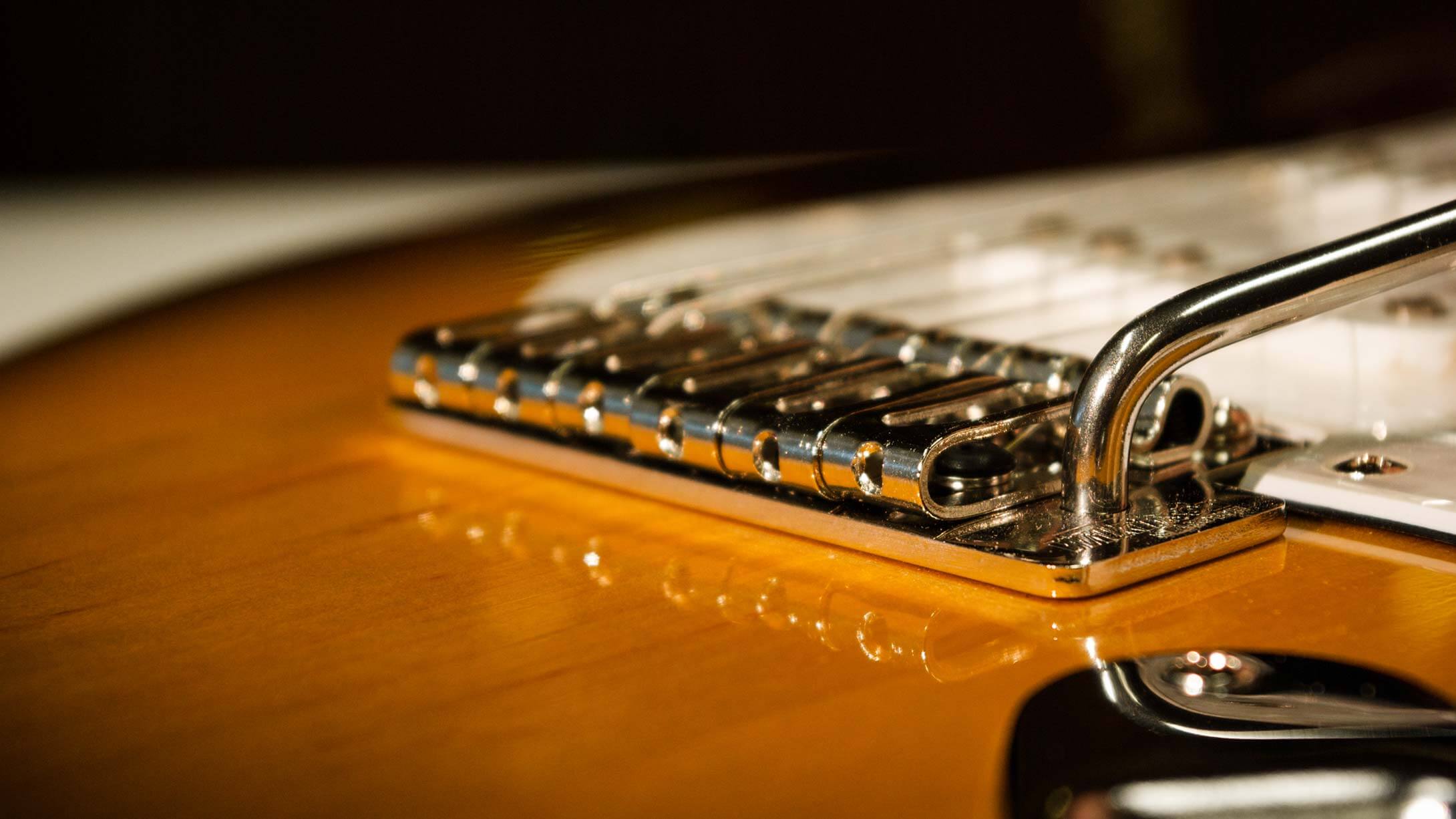
Floating mode – if you prefer your non-locking trem floating for smooth vibrato effect, adjust the springs so that there is a little gap (1.5 – 2.0mm) at the back edge of the tremolo base plate. To achieve the desired position you may need to adjust back and forth for a few times, as the tuning of the guitar changes every time you adjust the springs. You have succeeded, as the trem is floating as wanted and the guitar is in tune. If your guitar is equipped with locking trem (Gotoh GE1996 etc.), it’s usually set floating and the springs are adjusted correctly, when your guitar is in tune, and the trem baseplate remains in parallel position with the top of the guitar.
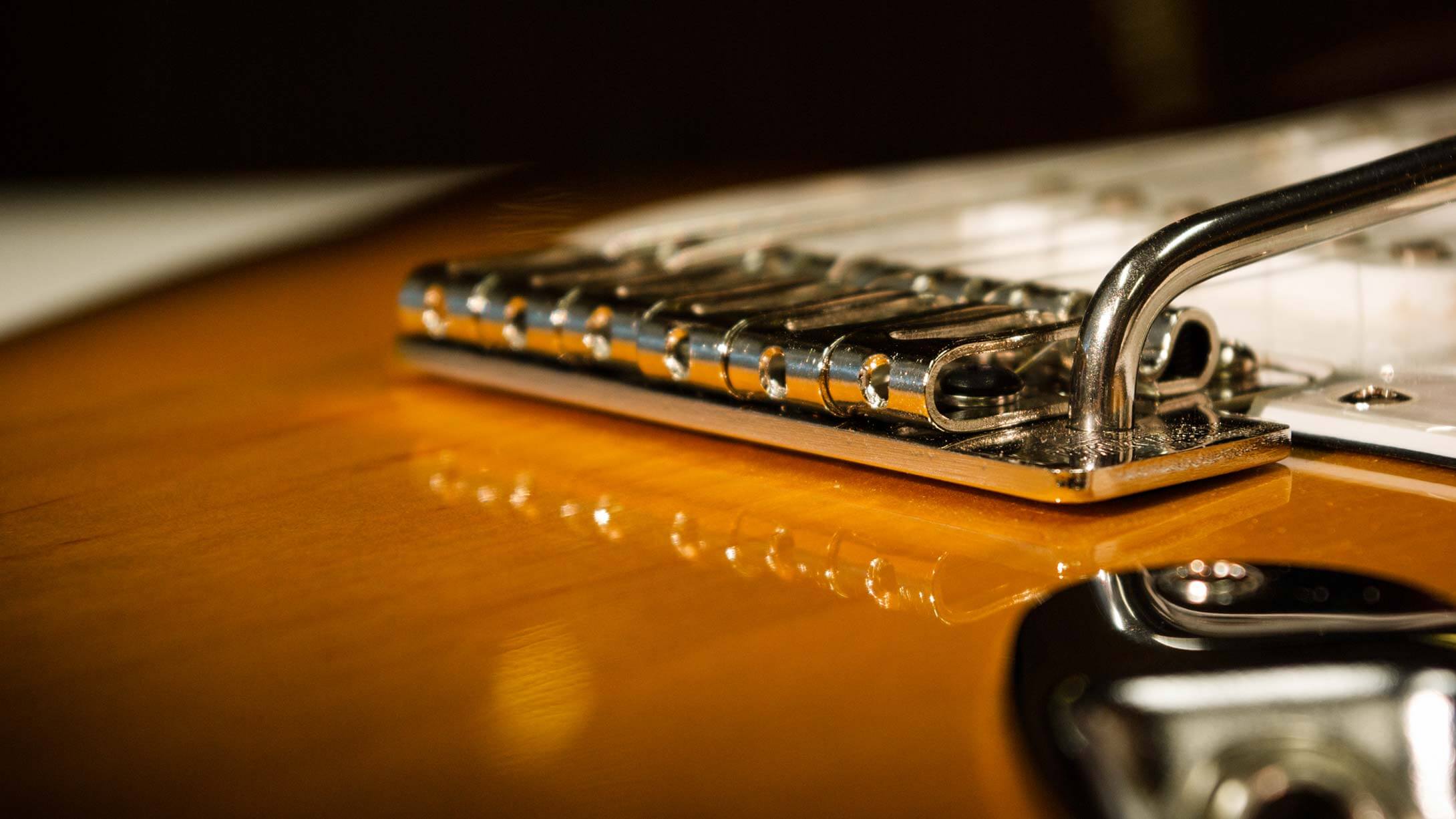
Non-floating mode – if you prefer using the non-locking tremolo only for down- bends, tighten the screws so that the baseplate stays flat on the top as the guitar is tuned up. It’s common to adjust the spring tension so, that you can bend the plain strings up a full step without the tremolo baseplate lifting up from top. If you use heavy gauge strings, the trem may need 4-5 springs to work correctly.
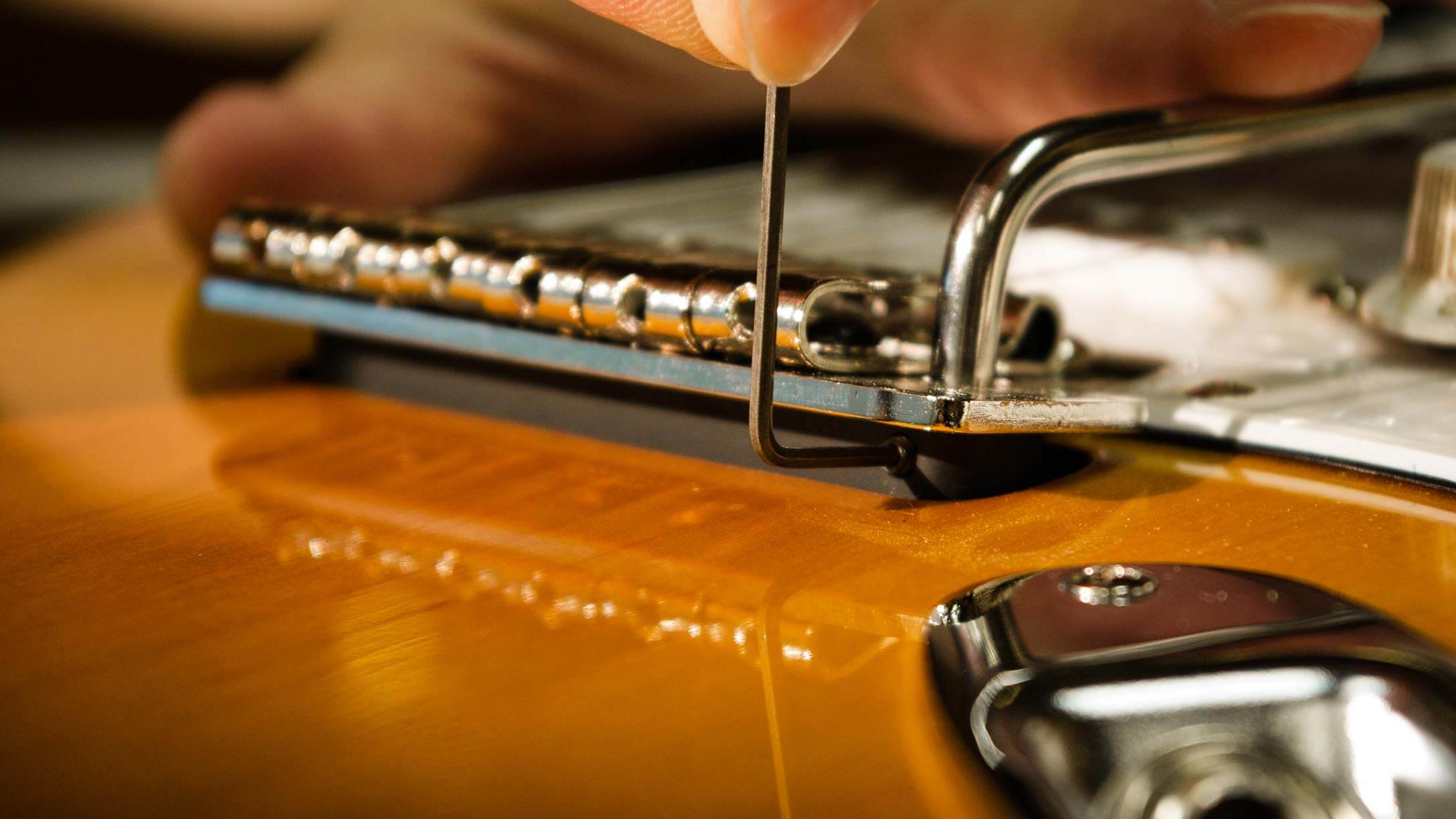
Trem arm tension – to adjust the Wilkinson (by Gotoh) VSVG trem arm tension, press the arm so that the bottom plate raises from the body about 1 cm. You can then see a small hex screw behind the sustain block. Tighten the slack off the arm by turning the tension screw clockwise with the 1.5mm hex key provided with your guitar. You can finetune the tension to your liking – some prefer the arm to drop down when not using it, while others may want it to remain in the playing position.
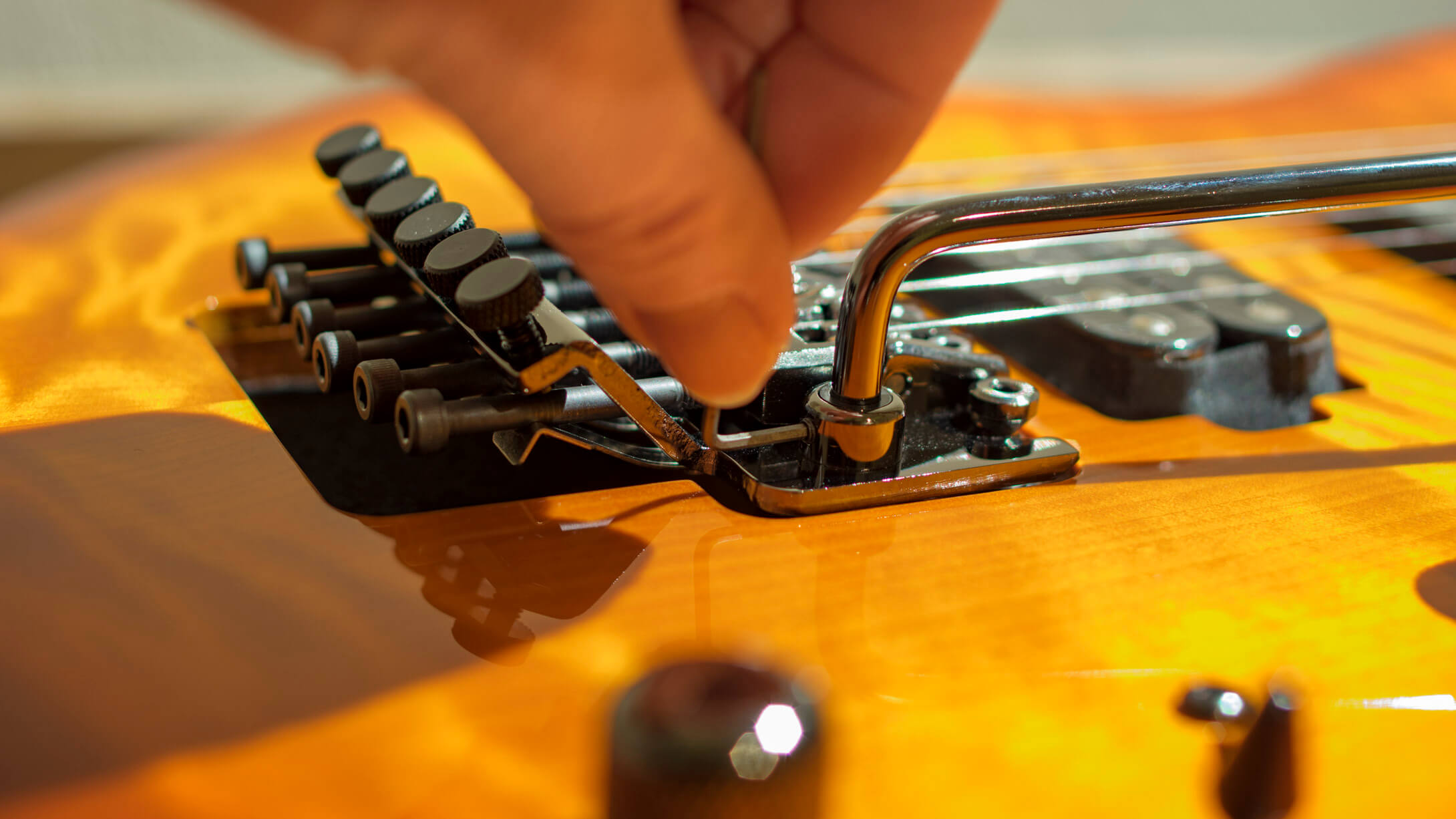
The Gotoh GE1996 trem arm has an internal threading to adjust the height of the arm. Push the arm in place and start turning clockwise. You can continue turning the arm as long as the depth feels comfortable for you. Don’t force the arm deeper than it goes easily – when it starts to feel snug, it’s time to stop. To adjust the trem arm tension, use the provided 1,5mm hex key.
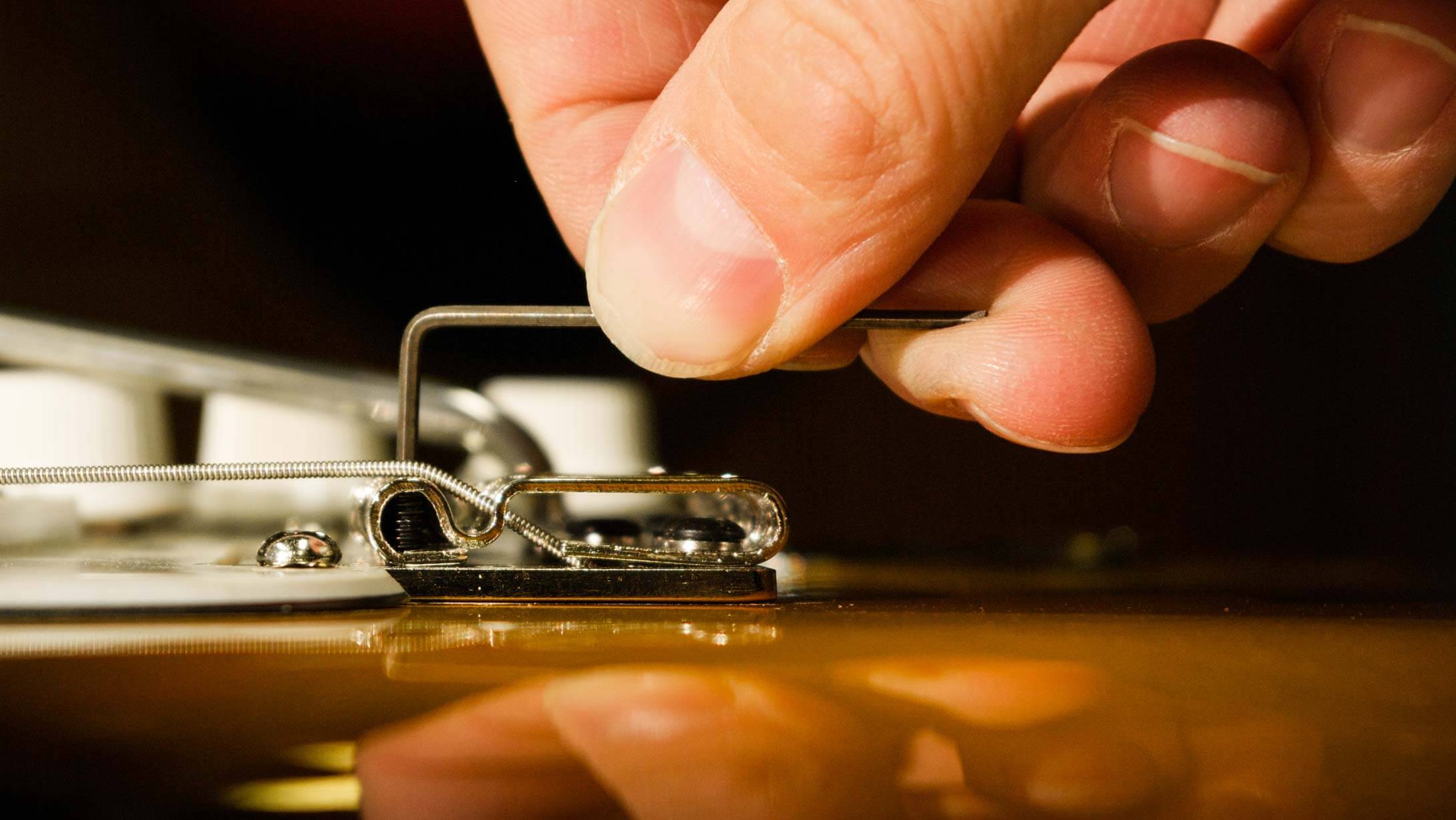
The string height of your Ruokangas guitar is adjusted at our workshop for comfy, relatively low action – measuring at 12th fret: low-e 1.8 – 2.0mm and high-e 1.5 – 1.7mm. These adjustments seem to work for most players – but then again, string height is always a matter of taste!
Wilkinson/Gotoh VSVG trem – adjust the low-E string to comfortable height with the provided 1,59mm (1/16”) hex key – and follow with setting the high-E string next. Follow by aligning the rest of the bridge saddles to match the fretboard radius.

Locking Gotoh GE1996 trem – unlock the posts with the provided 1.5mm hex key. Adjust the posts to comfortable height with the provided 3mm hex key. Locking trems do not have individual height adjustments for each string, and we have built the fretboard radius to match the radius of the trem. After adjustments lock the posts again with the 1.5mm key.
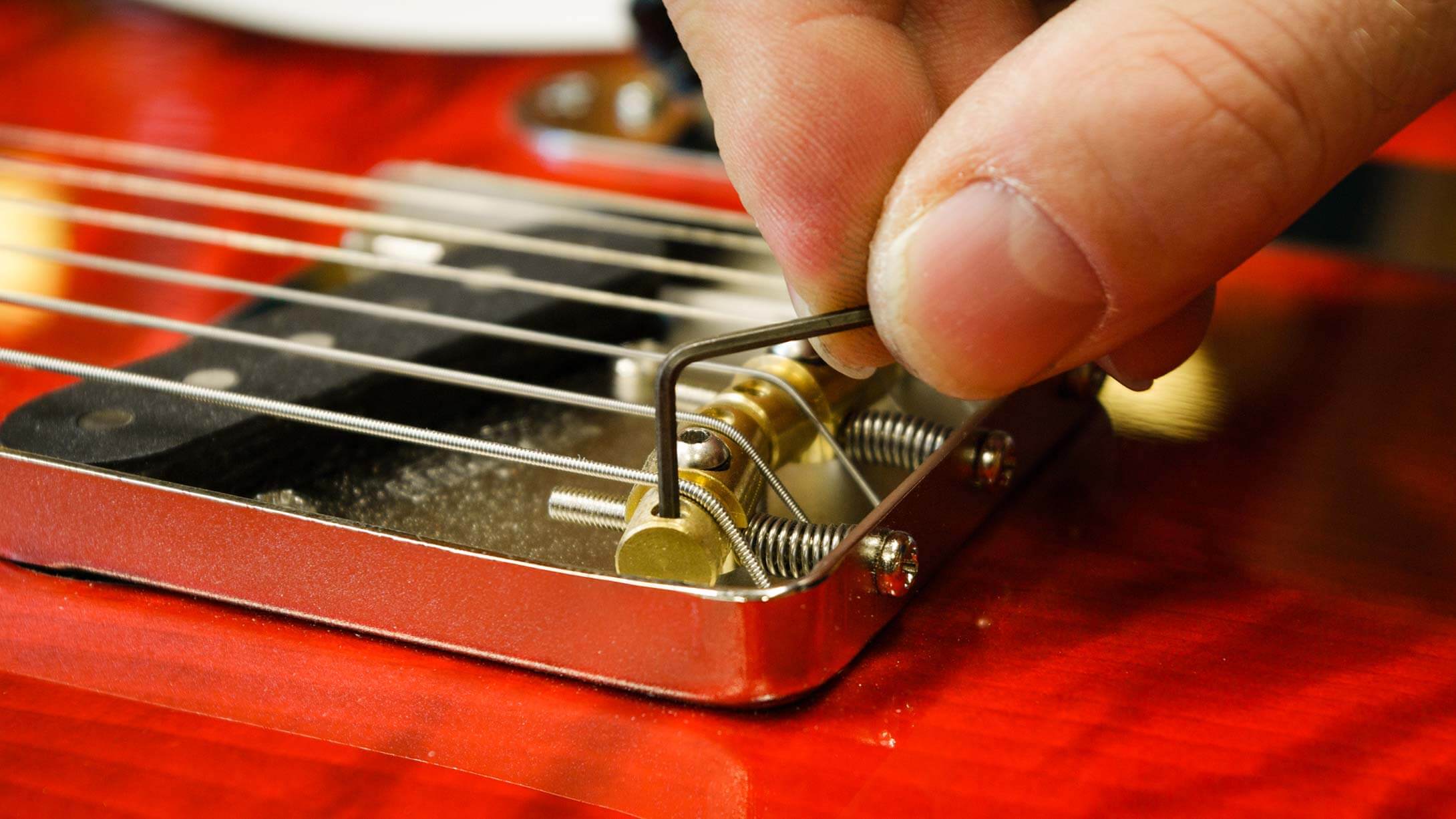
Wilkinson/Gotoh WT3 – the string height of the WT3 bridge is adjusted in pairs, two strings at a time. Start from low-E and A. Set the strings to comfortable height so that they follow the fretboard radius, using the provided 1.5mm hex key. Repeat procedure for the rest of the strings.
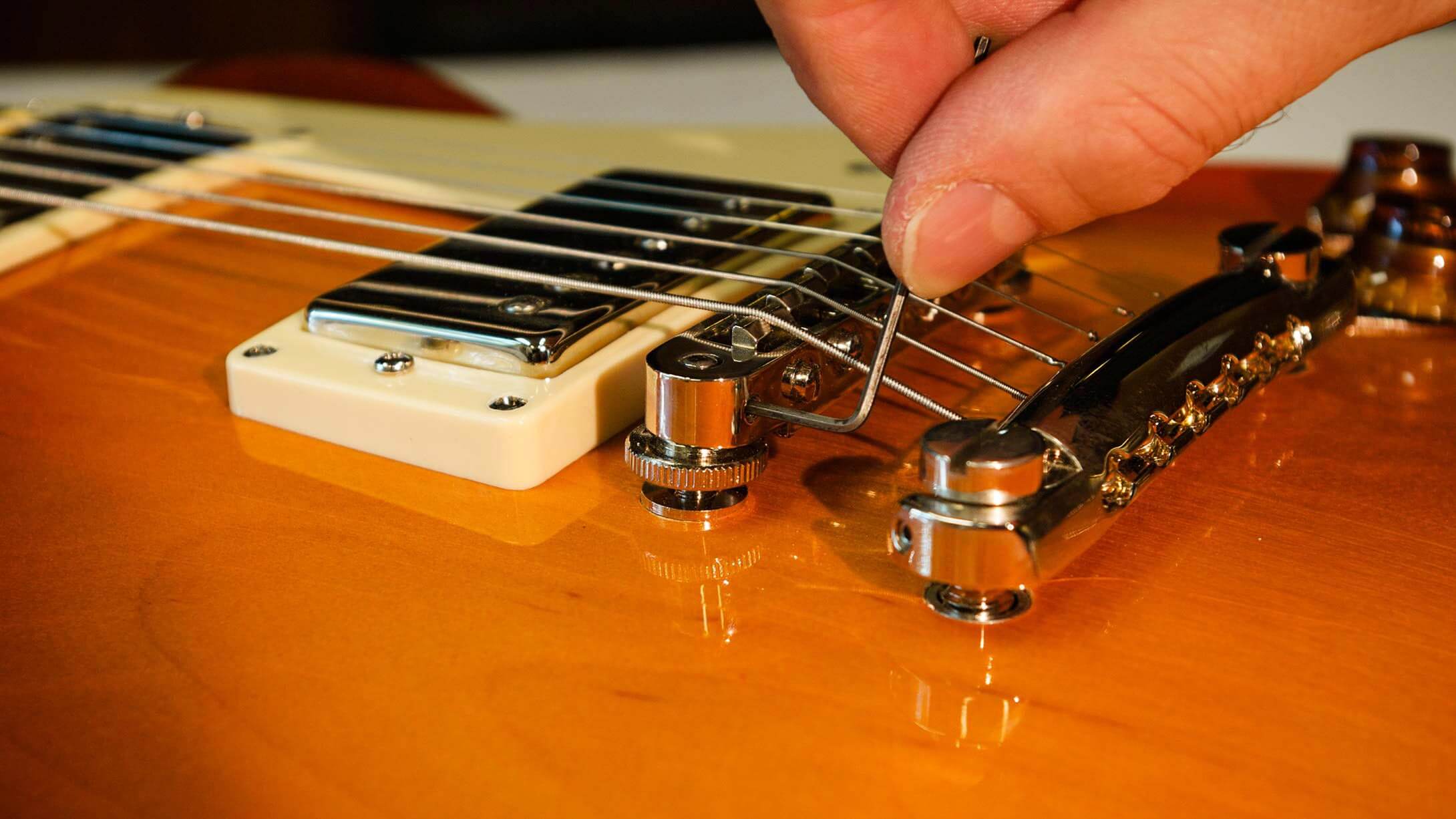
Tune-o-matic – the string radius of the tune-o-matic bridge matches the Ruokangas fretboard 12” radius. Your guitar has a tune-o-matic bridge and tailpiece manufactured either by ABM (2017 on), TonePros or Schaller. If you have TonePros, first unlock the bridge with the provided 1.5mm hex key. Then set the two thumbscrews to the desired height and tune up the guitar. In case of TonePros, lock the bridge after adjustments.
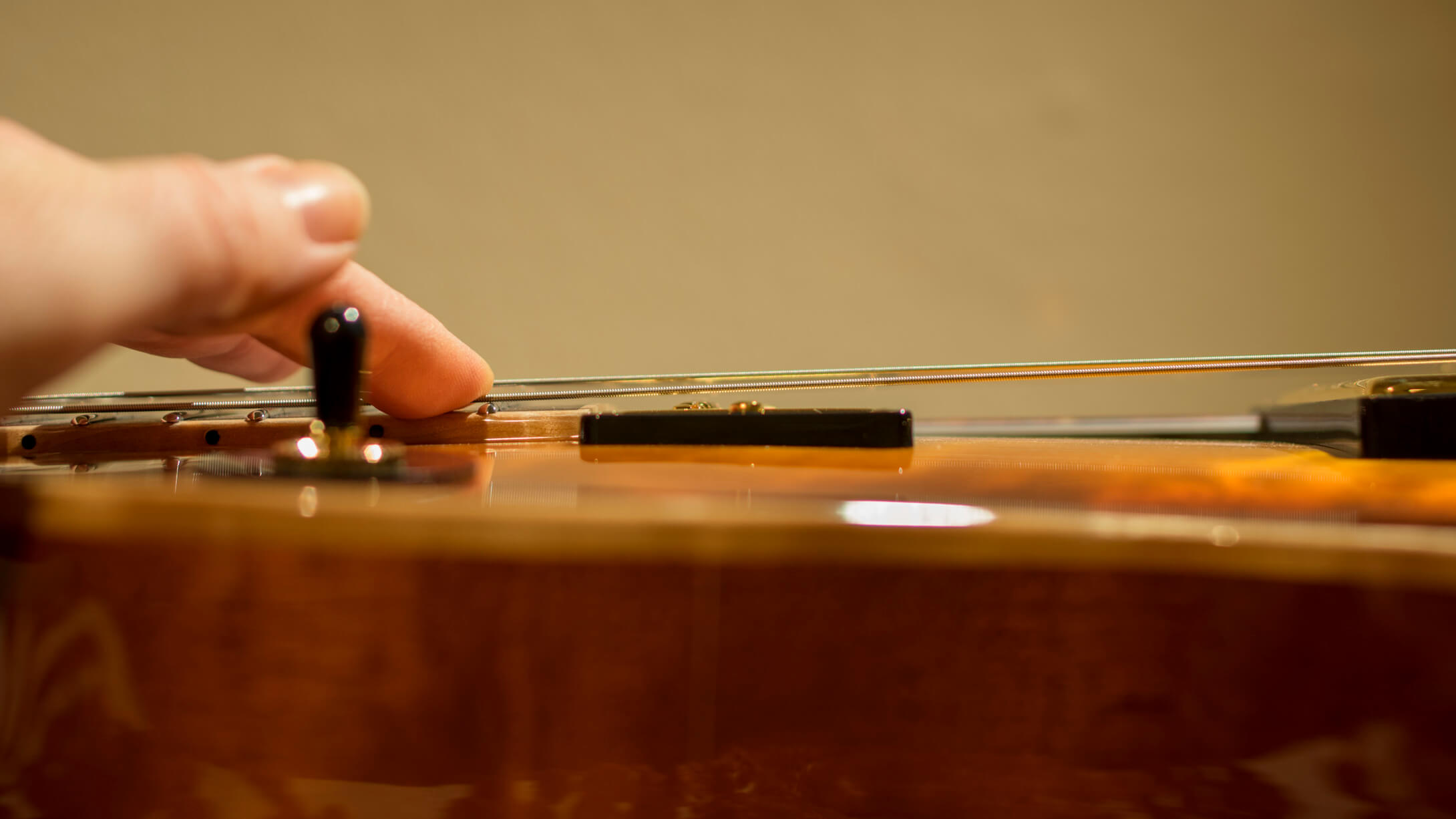
Pickup height – some manufacturers give standard heights for their pickups. This is, however, also a matter of taste. You can affect the tone of your guitar by moving the pickups closer or further away the strings. The closer the pickups are, the more aggressive and “in-your-face” the tone gets. You can also finetune the balance of the bass and treble strings by adjusting the pickup height.
If the pickups are too close, there are basically two problems that occur. The sustain suffers, as the strings can not vibrate freely in the strong magnetic field. There can also appear a funny effect – like the guitar would be badly out of tune when it’s not. This effect gets stronger the further up you go on the fretboard as the strings go closer to the pickups when fretted. You can hear the effect even when playing on a single string. Remember to check that there is always a gap (at least 2mm with humbuckers, 4mm with single coils) between the bottom of the string and top of the pickup as you play at the last fret on any string. Feel free to experiment with this – if you feel the tone should be just a bit brighter, try raising the pickups a bit higher. If you want it smoother, take them a little back. If the balance between the pickups doesn’t seem perfect for your playing style, sound and amplifier dynamics, slight adjustment may be all it takes.
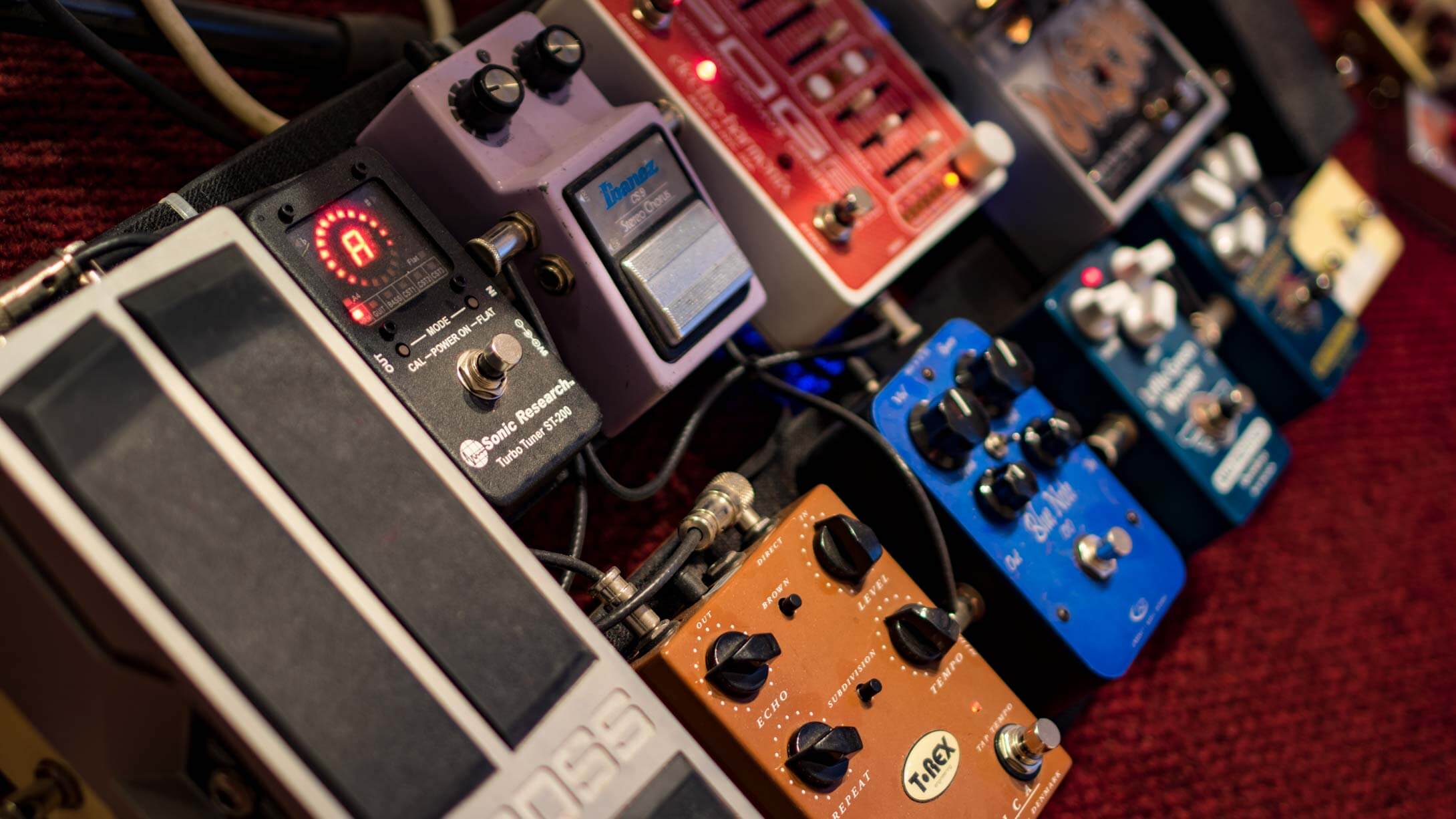
Intonation – last but not least – let’s check the intonation of the guitar. A high quality electronic tuner should be used to do this. The idea is to match the octave (fretted) note of the strings – one by one – with their corresponding 12th fret open harmonics by shortening or lengthening the strings with adjusting screws. As you have succeeded doing this, your guitar will be in tune no matter where you play on the fretboard. All Ruokangas guitars have proven to be extremely well “in-tune” when adjusted correctly. Notice that setting the intonation must always be done with a fresh set of strings!
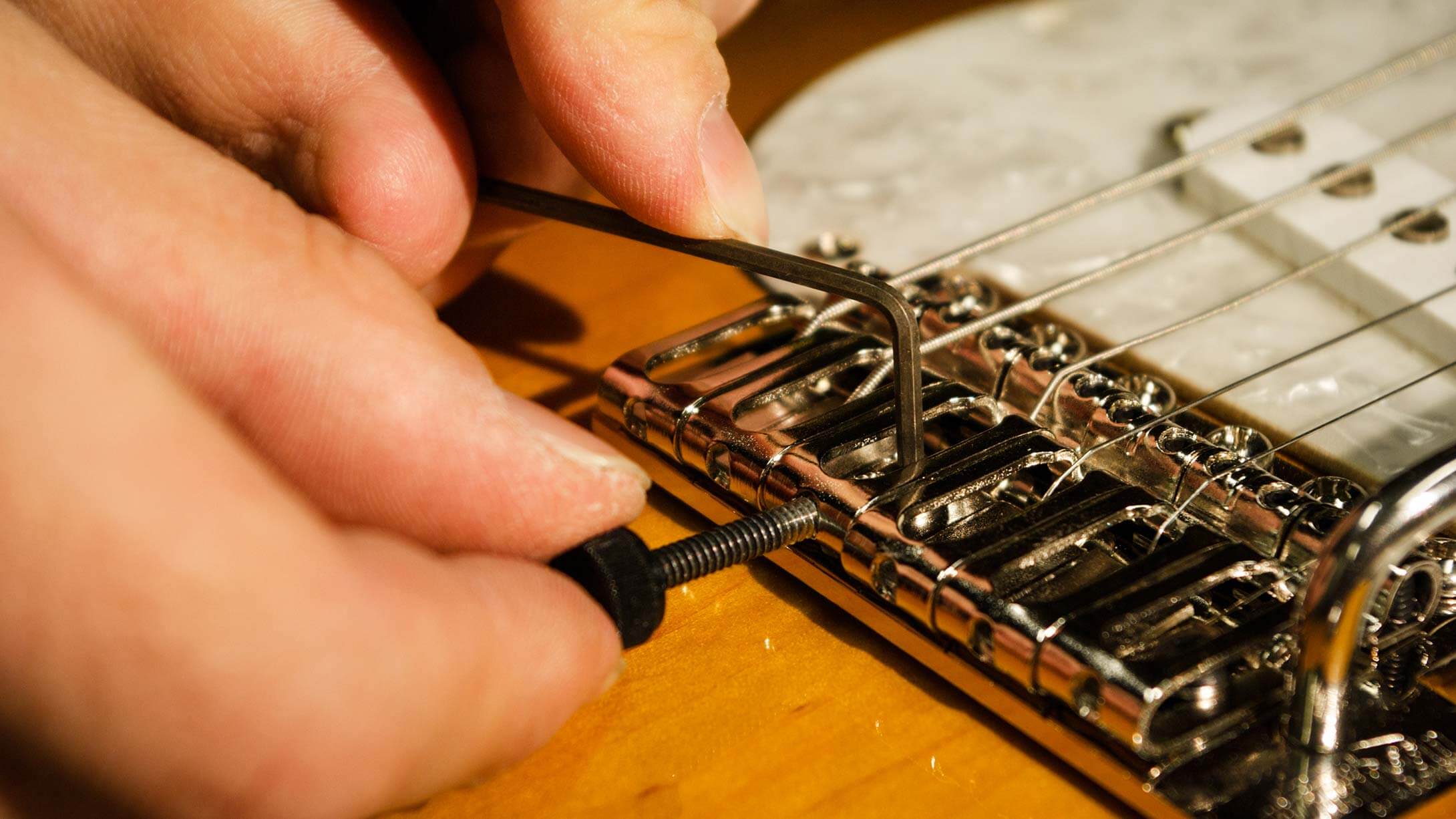
Wilkinson/Gotoh VSVG trem – first, check the intonation. If adjusting is needed, turn the thumbscrew (see the pic, tool for adjusting is provided with the guitar) into the threads at the back of the saddle. Open the saddle locking hex screw with the provided 2mm hex key and adjust the intonation with the thumbscrew. As the octave matches, lock the hex screw, remove the thumbscrew and move to next string. As all strings are adjusted, check again the tightness of all locking screws. Remember not to use excess force, as this will damage the locking hex screws.
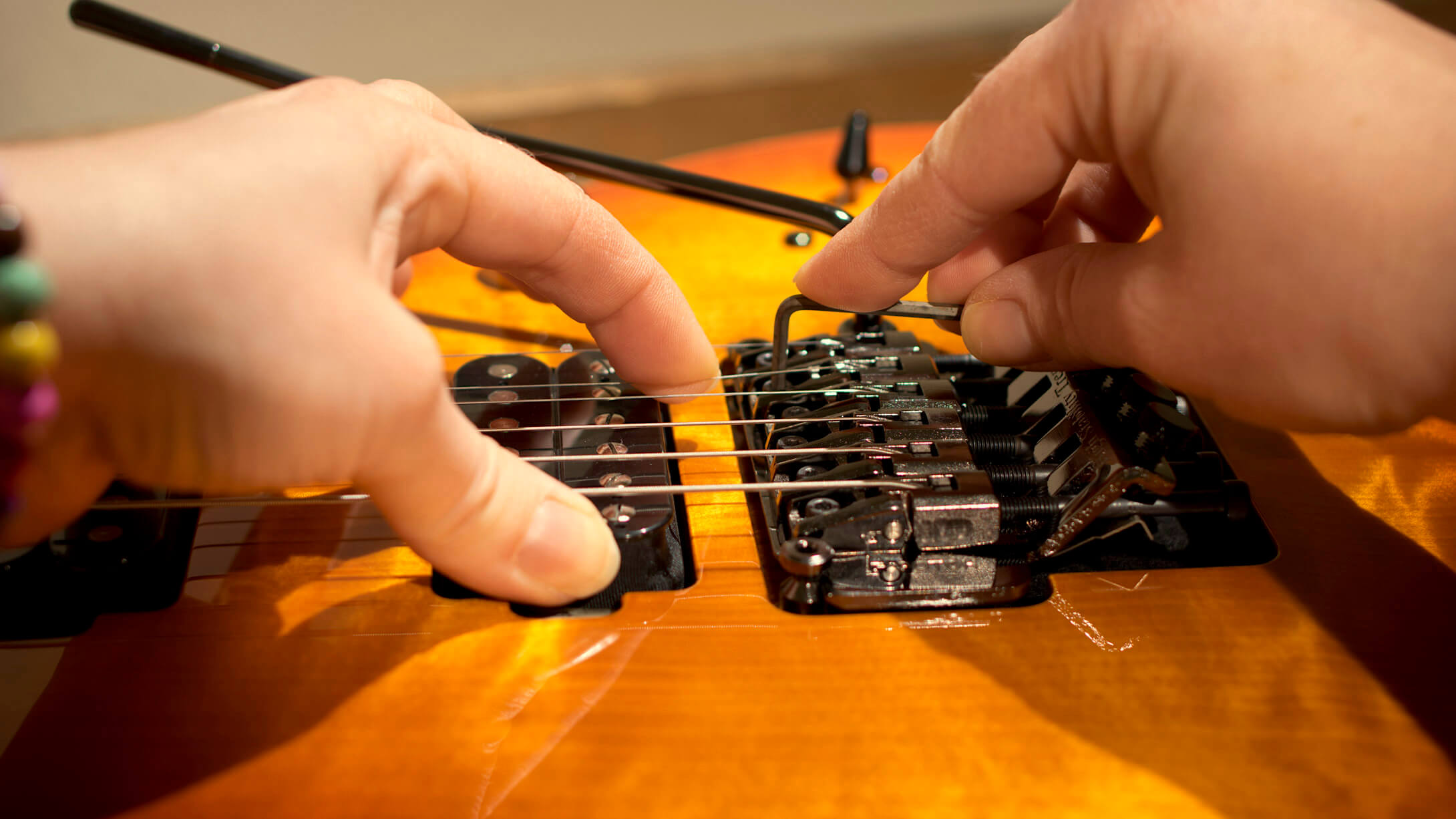
Gotoh GE1996 locking trem – check first the intonation. If adjustment is needed, loosen the string slightly. Open the saddle locking hex screw with the provided 2.5mm hex key slightly and tap the saddle to the appropriate direction. Lock the saddle. Retune, check the intonation. Repeat the procedure until the octave matches. Remember not to use excess force, as this will damage the locking hex screws.
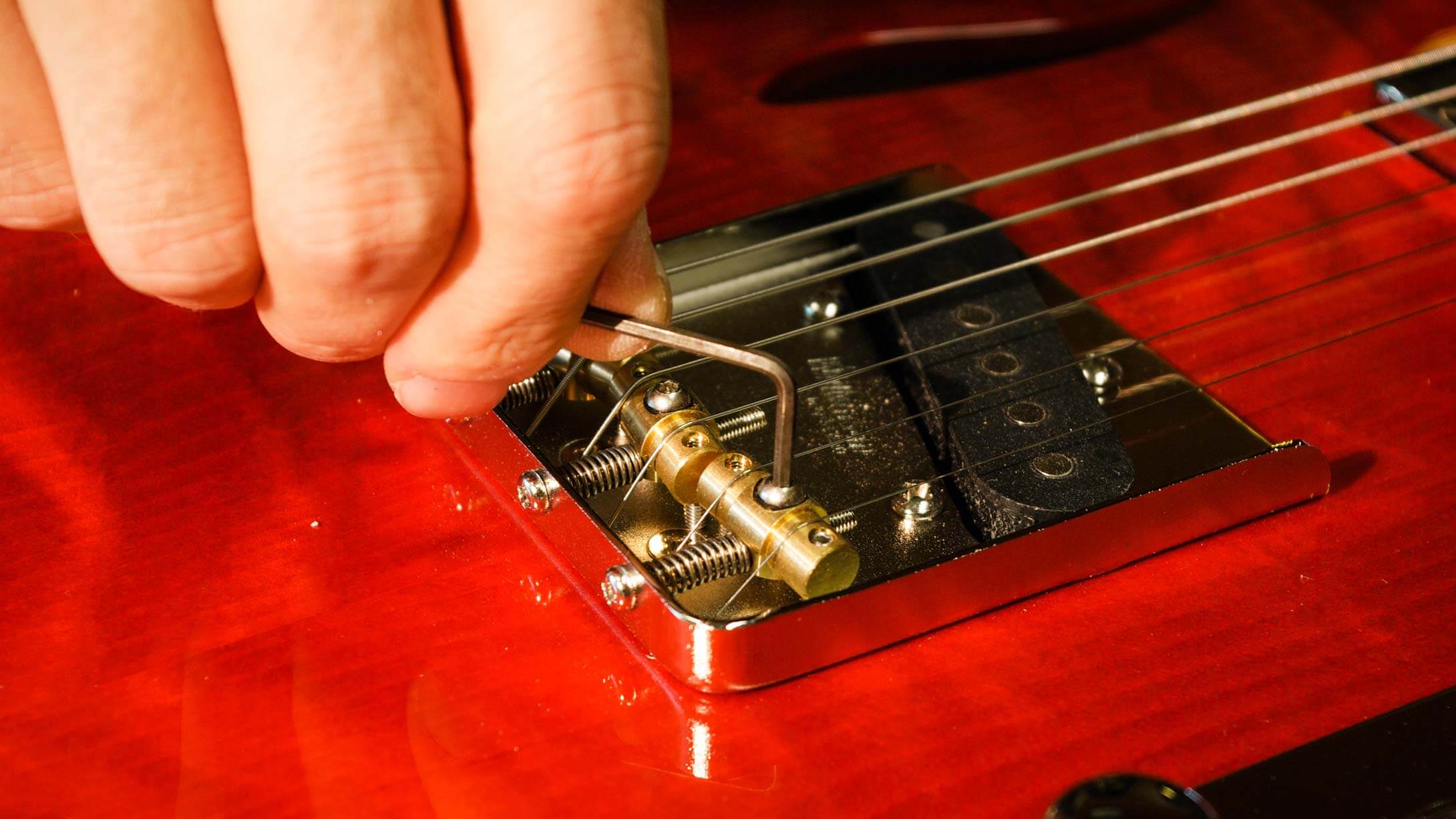
Wilkinson/Gotoh WT3 and WPB2 (bass bridge) – check the intonation in pairs, two strings at a time (EA, DG, BE). With a pair of strings, estimate the need of adjustment. You need to work both with the adjusting screw (with Phillips screwdriver) moving the whole saddle back and forth, and the rotating brass barrel. Use the provided 2mm hex key to loosen the barrel if needed. Tap the barrel to change it’s angle towards strings. When you get both strings on a single barrel to intonate correctly, lock the barrel and move on to the next pair of strings.
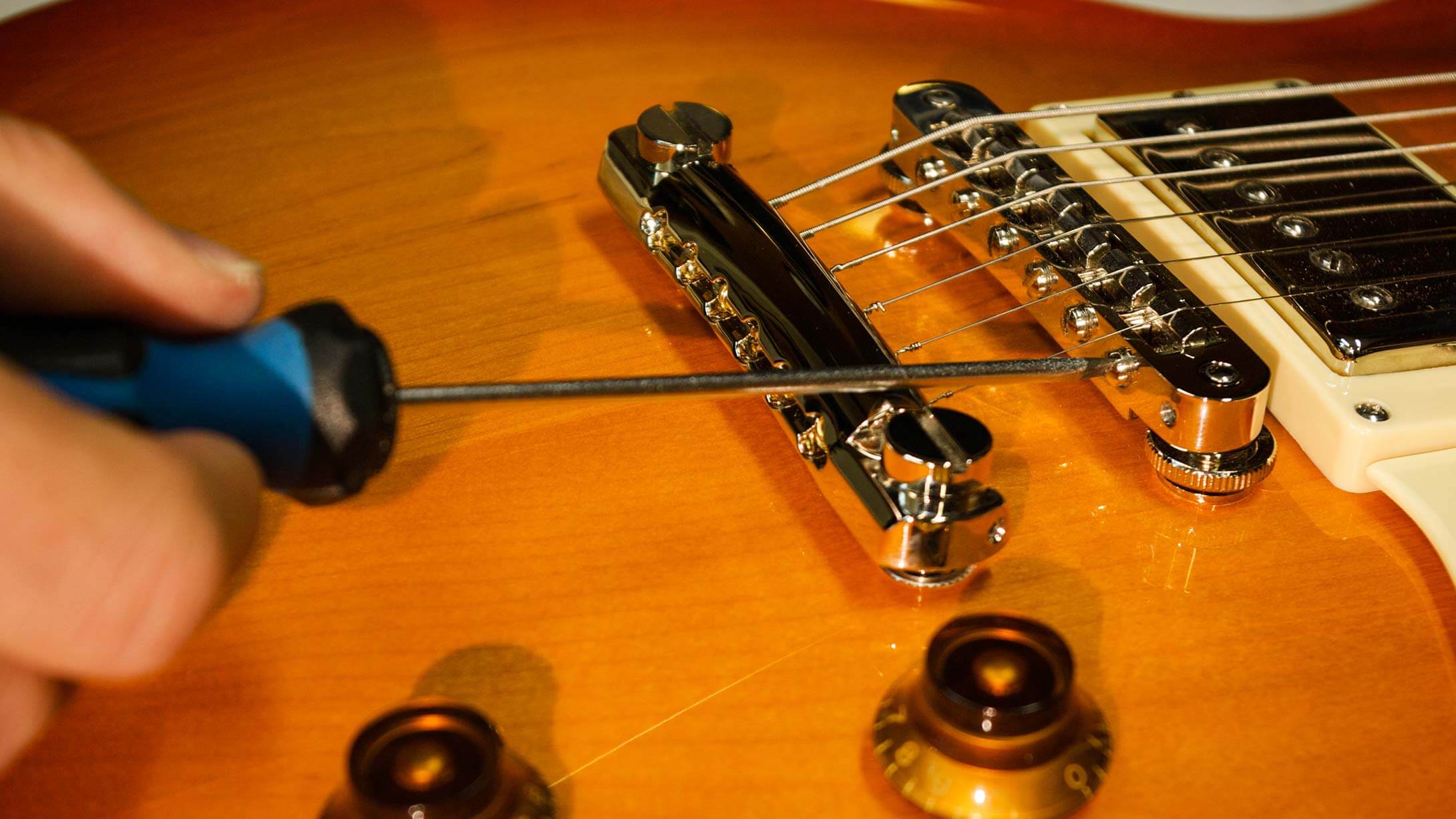
Tune-o-matic – the intonation is adjusted by using an appropriate flathead screwdriver. There are no locking screws, but if the adjusting screw feels very stiff, it is advisable to loosen the string slightly prior adjusting.
In case further adjusting/repair should be needed, doublecheck the set-up instructions. If you still feel unsatisfied with the results, contact your local pro repairshop or us for further assistance.
Those of you who want to know more about the hardware or other details of your Ruokangas guitar, have a look at the specifications articles on this website – there’s tons of info about bridges, tuners, tonewood, playability and much more!

